Upper Manistee Headwaters: The Milock Family Preserve Field Guide Wetland Plants and Habitats
 PHOTO: NOAH JURIK
PHOTO: NOAH JURIK
When the Grand Traverse Regional Land Conservancy (GTRLC) protected Upper Manistee Headwaters: The Milock Family Preserve through the Campaign for Generations, the property was among the highest-rated parcels for conservation. And rightly so—in addition to over a mile of frontage on the north branch of the Manistee River, the property is home to several kettle-hole ponds, a spring-fed lake and hundreds of acres of wetlands. Spanning over 1,300 acres, with another 342-acre addition pending (as of January 2024), the Kalkaska-county preserve ranks as one of the state’s most ecologically significant and rare habitats.
The exceptional quality of this rich wilderness is largely due to its multiple and diverse wetlands. Some of the most critical ecosystems in the world, wetlands serve as natural filters, providing food and habitat for various wildlife, protecting communities from flooding, sequestering carbon from the atmosphere and more. Unfortunately, many of our fragile wetlands have already diminished, and stressors like habitat fragmentation, pollution and invasive species threaten the health of those that remain.
The Conservancy’s staff have identified 10 types of wetland habitats at the preserve. The extreme diversity of habitats means that a wide variety of wildlife calls this special place home. This includes more than 365 plant species, most of which are native to Michigan, and dozens of birds, mammals, reptiles, amphibians and fish. Some of these species are listed as threatened or of special concern by the state.
The preserve’s high-quality wetlands also play a vital role in protecting water quality in the north branch of the Manistee River and, by extension, the rest of the Manistee River watershed. The Manistee rises just north of the preserve and drains 1,780 square miles before ultimately reaching Lake Michigan. As natural filters, these wetlands provide ecological benefits that flow downstream from the headwaters, impacting the health of the watershed as well as the Great Lakes.
In this guide, you will find information about these unique wetland habitats and the species that help identify them. The preserve’s trail system is ideal for viewing most of these habitats, especially in summer when many wetland plants begin blooming. Please note that because wetlands are dynamic systems, the habitats and species depicted in this guide may change over time and may not always be apparent. This guide does not describe the property’s upland habitats and does not include every plant found at the preserve. To view or add species observations captured by community scientists, search for the Upper Manistee Headwaters Preserve on inaturalist.org. For a complete list of plant species at the preserve, contact us at info@gtrlc.org.
Upper Manistee Headwaters: The Milock Family Preserve 2
Upper Manistee Headwaters: The Milock Family Preserve is one of 49 GTRLC protection projects to date in the Manistee River Watershed. Collectively they protect: over acres of land
8,738 over miles of shoreline
35 &
MANISTEE RIVER WATERSHED GTRLC SERVICE AREA

UPPER MANISTEE HEADWATERS: THE MILOCK FAMILY PRESERVE
MANISTEE RIVER WATERSHED FACTS
12 discharges gallons of water per second into Lake Michigan 13,000
drainage basin includes square miles and portions of
1,780 counties
Manistee River’s main branch is miles long with a elevation drop 232 671’
3 GTRLC.ORG
MANISTEERIVER
LAKE MICHIGAN
ANTRIM
KALKASKA GRAND TRAVERSE BENZIE MANISTEE
How to Use This Guide
This guide can be used as a trail companion while exploring the Upper Manistee Headwaters Preserve or for simply learning about the preserve’s fascinating wetland habitats.
The first section describes the preserve’s 10 wetland habitat types, with a list of the native plant species indicative of each habitat compiled by MSU Extension’s Michigan Natural Features Inventory (MNFI). The species listed in bold were chosen as important indicators for each habitat type. The second section provides details about these particular species, with images and interesting information about each plant. Please note that certain species may appear in more than one habitat.
Navigating Section 1 (Wetland Types):
Wetland type and group
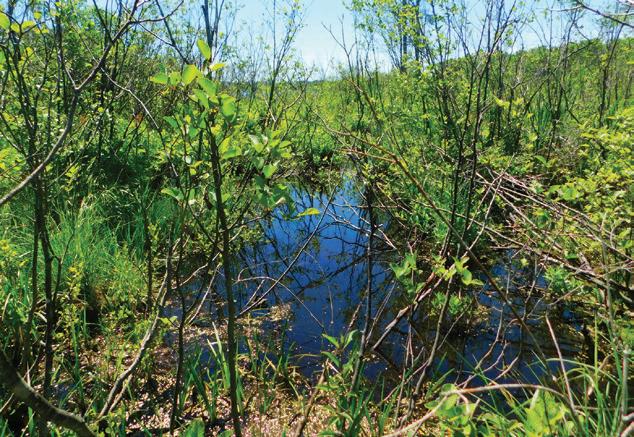
Northern Shrub Thicket Plant Species
GRAMINOIDS
Blue-joint (Calamagrostis canadensis)
Fowl Manna Grass (Glyceria striata)
Fowl Meadow Grass (Poa palustris)
Green Bulrush (Scirpus atrovirens)
Lake Sedge (Carex lacustris)
Rattlesnake Grass (Glyceria canadensis)
Retrorse Sedge (Carex retrorsa)
Tussock Sedge (Carex stricta)
FORBS
Canada Goldenrod (Solidago canadensis)
Common Boneset (Eupatorium perfoliatum)
Common Skullcap (Scutellaria galericulata)
Great Water Dock (Rumex orbiculatus)
Jewelweed (Impatiens capensis)
Joe-pye-weed (Eutrochium maculatum)
Late Goldenrod (Solidago gigantea)
Mad-dog Skullcap (Scutellaria lateriflora)
Marsh Bellflower (Campanula aparinoides)
Marsh Cinquefoil (Comarum palustre)
Northern Blue Flag Iris (Iris versicolor)
Northern Bugle Weed (Lycopus uniflorus)
Marsh-marigold (Caltha palustris)
Panicled Aster (Symphyotrichum lanceolatum)
Purple Meadow-rue (Thalictrum dasycarpum)
Rough Bedstraw (Galium asprellum)
Rough Goldenrod (Solidago rugosa)
FERN ALLIES
Common Horsetail (Equisetum arvense)
SHRUBS
American Highbush-cranberry (Viburnum
trilobum)
Black Chokeberry (Aronia prunifolia)
Bog birch (Betula pumila)
Buttonbush (Cephalanthus occidentalis)*
Dwarf raspberry (Rubus pubescens)
Meadowsweet (Spiraea
Color references
wetland type shown on the map on page 8
Swamp Aster (Symphyotrichum puniceum)
Swamp Milkweed (Asclepias incarnata)
Wild Calla (Calla palustris)
Wild Mint (Mentha canadensis)
FERNS
Cinnamon Fern (Osmunda cinnamomea)
Marsh Fern (Thelypteris palustris)
Royal Fern (Osmunda regalis)*
Sensitive Fern (Onoclea sensibilis)
Full list of species found in each wetland type from MSU Extension’s Michigan Natural Features Inventory. Species in bold are important indicators for each habitat type and are featured in section 2 of this guide.
Upper Manistee Headwaters: The Milock Family Preserve 4
Upper Manistee Headwaters: The Milock Family Preserve | Wetland Types 26 27 GTRLC.ORG 7. Northern Shrub Thicket | Shrub Wetland Group If you’re in an area of the preserve that feels like a mangrove swamp, you’re likely in a northern shrub thicket or “tag alder swamp.” At the Upper Manistee Headwaters Preserve, this wetland habitat forms extensive shrub forests along the streams, lakes and along the edges of bogs and fens. A classic species, tag alder supports the habitat’s entire ecosystem. The shrub’s unique adaptation provides a distinct advantage; its roots’ symbiotic relationship with bacteria enables the plant to take nitrogen from the air and transfer it into the soil. Thus, tag alder can grow in stagnant waters with a limited nitrogen supply. This wetland community has nutrient-rich,
frequently floods in the spring. As water levels fluctuate in lakes and streams, open wetlands often convert to northern shrub thickets. The dense growth of tag alder and other shrubs helps slow water and improve water quality by trapping sediment and erosion.
???
wet-to-moist soils and
PHOTO:
alba) Red-osier Dogwood (Cornus sericea) Silky Dogwood (Cornus amomum) Swamp Dewberry (Rubus hispidus) Swamp Rose (Rosa palustris) Sweet Gale (Myrica gale) Tag Alder (Alnus incana)* Wild-raisin (Viburnum cassinoides) Wild Red Raspberry (Rubus strigosus) Willows (Salix bebbiana, S. discolor, S. exigua, S. petiolaris) Winterberry (Ilex verticillata)* TREES Balsam Fir (Abies balsamea) Black Ash (Fraxinus nigra) Black Spruce (Picea mariana) Northern White-cedar (Thuja occidentalis) Red Maple (Acer rubrum) Tamarack (Larix laricina) White Pine (Pinus strobus)
species featured in the section 2 of this guide
*Indicator
Also, please remember that the habitats and species described in this guide may change over time and may not always be visible. Generally, the wetland habitats marked with numbers on the map (on page 8) are noticeable from the trail at certain times of the year. Some habitats described here exist at the preserve but cannot be observed from the trail. Please refrain from accessing these areas, as natural wetland communities are vulnerable to disturbance, and traversing through them may harm the sensitive species we have worked to protect.
Navigating Section 2 (Wetland Plants):
Common and scientific names
Wetland type where this species is featured in section 1
Time of year this plant is most easily observed
“Coefficient of Conservatism”, see page 35 for more information
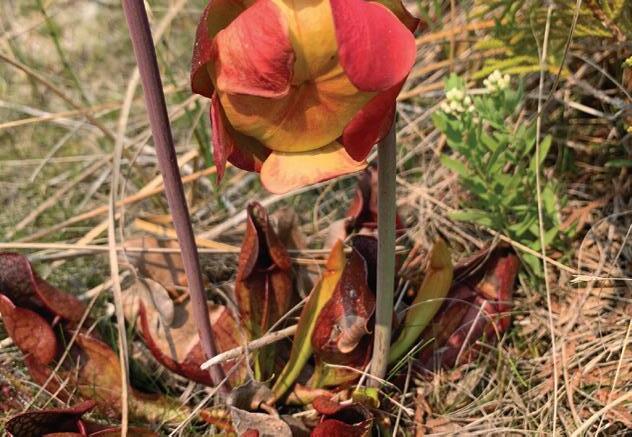
5 GTRLC.ORG
Upper Manistee Headwaters: The Milock Family Preserve | Plants 56 PHOTO: NATE RICHARDSON Pitcher Plant (Sarracenia purpurea) Featured Wetland Type: Bog Other Wetland Types: Muskeg, Poor Conifer Swamp, Poor Fen Best Season: Spring-Fall C Value: 10 Although pitcher plants are a diverse group, this is the only member of the family in Michigan. This fascinating species has deep maroon-colored petals on blooms that stick out above its modified leaf structures. The leaves form “pitchers” that trap insects, providing additional nutrients and minerals that are often lacking in the nutrient-poor habitats where it thrives. Fun Fact: Considered among the most ravenous plants, this unique species is capable of trapping thousands of insects. Sarracenia purpurea lacks a hood, which allows rainwater to enter its “pitcher” and insects are killed by drowning in water. As the water dries out the insects are digested by the leaves of the plant.
SECTION 1: WETLAND HABITAT TYPES
Upper Manistee Headwaters: The Milock Family Preserve | Wetland Types 6
Wetlands are areas of land saturated with water, either permanently, seasonally or temporarily. They are considered among the most biologically diverse ecosystems—after all, every living species needs water to thrive.
In Michigan’s freshwater landscape, these natural communities most often occur near lakes, rivers and streams. The state has many types of wetland habitats, which vary due to differences in vegetation, soils, climate, hydrology and other factors, and each is important for various plants and animals.
The Upper Manistee Headwaters Preserve contains some of the state’s most critical and diverse wetland habitats. Protection of this place safeguards the entire shoreline of spring-fed Grass Lake and more than a mile of frontage along the north branch of the Manistee River. Since 2017, biological inventories and research studies by expert ecologists have helped distinguish 10 distinct types of wetlands at the preserve.
Because wetlands are dynamic systems that fluctuate depending on water levels, seasonality and other environmental influences, identifying wetland habitats is not straightforward. To further complicate this process, different types of wetlands may occur within the same area and researchers use differing classification systems. In creating this guide, GTRLC used the plant lists and natural community key developed by the Michigan Natural Features Inventory (MNFI), a program of Michigan State University Extension.
While this guide describes the property’s critical wetlands, the preserve’s mixed northern mesic forests, vernal pools and open fields also provide valuable habitat and contribute to the health of the wetlands.
7 GTRLC.ORG

Upper Manistee Headwaters: The Milock Family Preserve | Wetland Types 8 Grass Lake Rd N Grass Lake Rd County Road 612 North Branch Manistee River Darke Rd Manistee Lake PostLake µ Grass Lake Parking LEGEND Nature Preserve Parking Bog Muskeg Poor Fen Submergent Marsh Emergent Marsh Northern Wet Meadow Northern Shrub Thicket Hardwood-Conifer Swamp Rich Conifer Swamp Poor Conifer Swamp Perch Lake ! 2 ! 1 ! 3 ! 5 ! 6 ! 4 ! 7 ! 8 ! 9 ! 10 PROTECTING SIGNIFICANT NATURAL, SCENIC, AND FARM LANDS—AND ADVANCING STEWARDSHIP—NOW AND FOR FUTURE GENERATIONS UPPER MANISTEE HEADWATERS: THE MILOCK FAMILY PRESERVE WETLAND TYPES MAP 2024
Intersections/ Trail Maps Nature Preserve Hiking-only Trail Universally Accessible Trail Mixed-use Trail (Hiking, Biking, Skiing) Proposed “Excelsior” the Perch Lake Addition Proposed Addition
LEGEN D
Wetland Habitats by Group Type
MNFI has identified six groups of wetlands containing 32 natural community types. In this field guide, however, are only the 10 wetland habitats and five groups found at the Upper Manistee Headwaters Preserve.
9 GTRLC.ORG
4. Bog 5. Muskeg BOG GROUP 7. Northern Shrub Thicket SHRUB WETLAND GROUP 6. Poor Fen FEN GROUP 9. Poor Conifer Swamp 10. Rich Conifer Swamp 8. Hardwood Conifer Swamp FORESTED WETLAND GROUP
GROUP 2. Emergent Marsh 1. Submergent Marsh 3. Northern Wet Meadow
MARSH
MARSH GROUP
Marshes thrive in water bodies such as lakes, ponds, rivers and streams. The soil and water levels can vary seasonally and from year to year, with soils typically wet and full of organic matter.
EMERGENT MARSH
SUBMERGENT MARSH OPEN WATER
As the name suggests, vegetation in an emergent marsh habitat “emerges” from shallow water whereas the majority of vegetation in a submergent marsh is “submerged” below water.
(Full habitat description, page 16)
NORTHERN WET MEADOW
Northern wet meadows are areas of periodic flooding usually recognizable by grassy species (like sedges and other graminoids) and wildflowers (like joe-pye weed and swamp milkweed). They often border other wetland communities and are often part of large wetland complexes.
(Full habitat description, page 18)
Upper Manistee Headwaters: The Milock Family Preserve | Wetland Types 10
BOG GROUP
Bogs are open peatlands characterized by a continuous carpet of sphagnum moss, a species-poor herbaceous layer, low ericaceous, evergreen shrubs, and stunted conifer trees.
BOG
Very Minimal Stunted Trees
Water
Bog Mat
Saturated Peat
Bogs are open, wetland habitats defined by acidic, saturated peat and large amounts of mosses and Ericaceae (heath) shrubs. They often have a floating mat of vegetation and sparse tree cover.
(Full habitat description, page 20)
Stunted Trees
MUSKEG / TREED BOG
Water
Thick Bog Mat
Saturated Peat
This rare habitat is similar to a bog but a defining difference is that as a result of succession and vegetation growth, it has a floating bog mat capable of supporting trees.
(Full habitat description, page 22)
11 GTRLC.ORG
FEN GROUP
Fens are unique, open peatlands that can be found throughout Michigan. They are fed by groundwater and are dominated by graminoids, forbs, shrubs and stunted conifers.
POOR FEN
Area of periodic flooding
Saturated Peat
These grassy, open, periodically flooded wetlands may look similar to a northern wet meadow but they feature acidic, saturated peat and have a springy feel under your feet. You will primarily see sedge species in a poor fen and a few small, scattered evergreen shrubs and conifer trees.
(Full habitat description, page 24)
SHRUB WETLAND GROUP
Shrub wetlands can be found in kettles and depressions on a variety of landforms. These wetlands develop in soils with varying depths that can be organic or mineral-based and are typically saturated or inundated.
NORTHERN SHRUB THICKET
Area of periodic flooding
Area of periodic flooding
If you’re in an area of the preserve that feels like a mangrove swamp, you’re likely in a northern shrub thicket or “tag alder swamp”. This wetland community has nutrient-rich, wet-to-moist soils and frequently floods in the spring. Tag alders are uniquely adapted to thrive in stagnant waters making them the hallmark species for this wetland type.
(Full habitat description, page 26)
Upper Manistee Headwaters: The Milock Family Preserve | Wetland Types 12
Open Water Tag Alder Tag Alder
FORESTED WETLAND GROUP
Forested Wetlands are found in depressions on glacial moraines, lake plains, outwash channels, poorly drained lake plains and within kettles on pitted outwash plains and ice-contact topography.
HARDWOOD CONIFER SWAMP
Area of periodic flooding influenced by groundwater
The term “swamp” refers to forested wetlands. Hardwood conifer swamps generally have less saturated conditions than other forested wetlands and are dominated by a mix of hardwoods and conifer trees.
(Full habitat description, page 28)
POOR CONIFER SWAMP
Coniferous Tree Layer
Shrub Layer
Saturated Peat Soils
A poor conifer swamp is characterized by coniferous trees like black spruce (Picea mariana) and tamarack (Larix laricina), along with sphagnum mosses and ericaceous shrubs growing on peat soils.
(Full habitat description, page 30)
RICH CONIFER SWAMP
Sometimes called “cedar swamps,” this forested wetland type is dominated by northern white cedar (Thuja occidentalis). Due to the high water table, trees are shallow-rooted and susceptible to blowdown, creating “tip-ups” resulting in many openings for forbs and shrubs to grow.
(Full habitat description, page 32)
13 GTRLC.ORG

1. Submergent Marsh | Marsh Group
This dynamic, fluctuating habitat is often compared to an “underwater forest” and is common throughout Michigan’s small, shallow lakes and ponds, as well as along the shores of large lakes. Submergent marshes usually occur in open water that is slightly deeper than emergent marsh habitats, but in clear lakes, plants can grow in water greater than 10 meters deep. Submergent vegetation can also form dense beds along the margins of slow-moving streams or open, less diverse plant beds in more rapidly flowing streams.
Plants that usually thrive in submergent marsh habitats include pondweeds, waterweeds, bladderworts and coontail. While most plants are submerged underwater, certain floating-leaf species can be observed in shallow waters. As you trek along the preserve’s shorelines, keep an eye out for yellow pond lily (Nuphar canadensis) and white waterlily (Nymphaea odorata), which are the most visible signs of this habitat type.
For a visual diagram of this habitat type, see page 10.
Upper Manistee Headwaters: The Milock Family Preserve | Wetland Types 14
PHOTO: ART BUKOWSKI
Submergent Marsh Plant Species
SUBMERGENT PLANTS
Bladderworts (Utricularia cornuta, U. gibba, U. intermedia, U. resupinata and U. vulgaris)*
Coontail (Ceratophyllum demersum)
Muskgrasses (Chara spp.)
Naiads (Najas flexilis and others)
Pondweeds (Potamogeton spp.)
Submergent Bulrush (Schoenoplectus subterminalis)
ROOTED FLOATING-LEAVED PLANTS
Pondweeds (Potamogeton spp.)
Sweet-scented Waterlily (Nymphaea odorata)*
Water-shield (Brasenia schreberi)*
Yellow Pond Lily (Nuphar variegata)*
NON-ROOTED LEAVED PLANTS
Great Duckweed (Spirodela polyrhiza)
Small Duckweed (Lemna minor)
*Indicator species featured in the section 2 of this guide
15 GTRLC.ORG
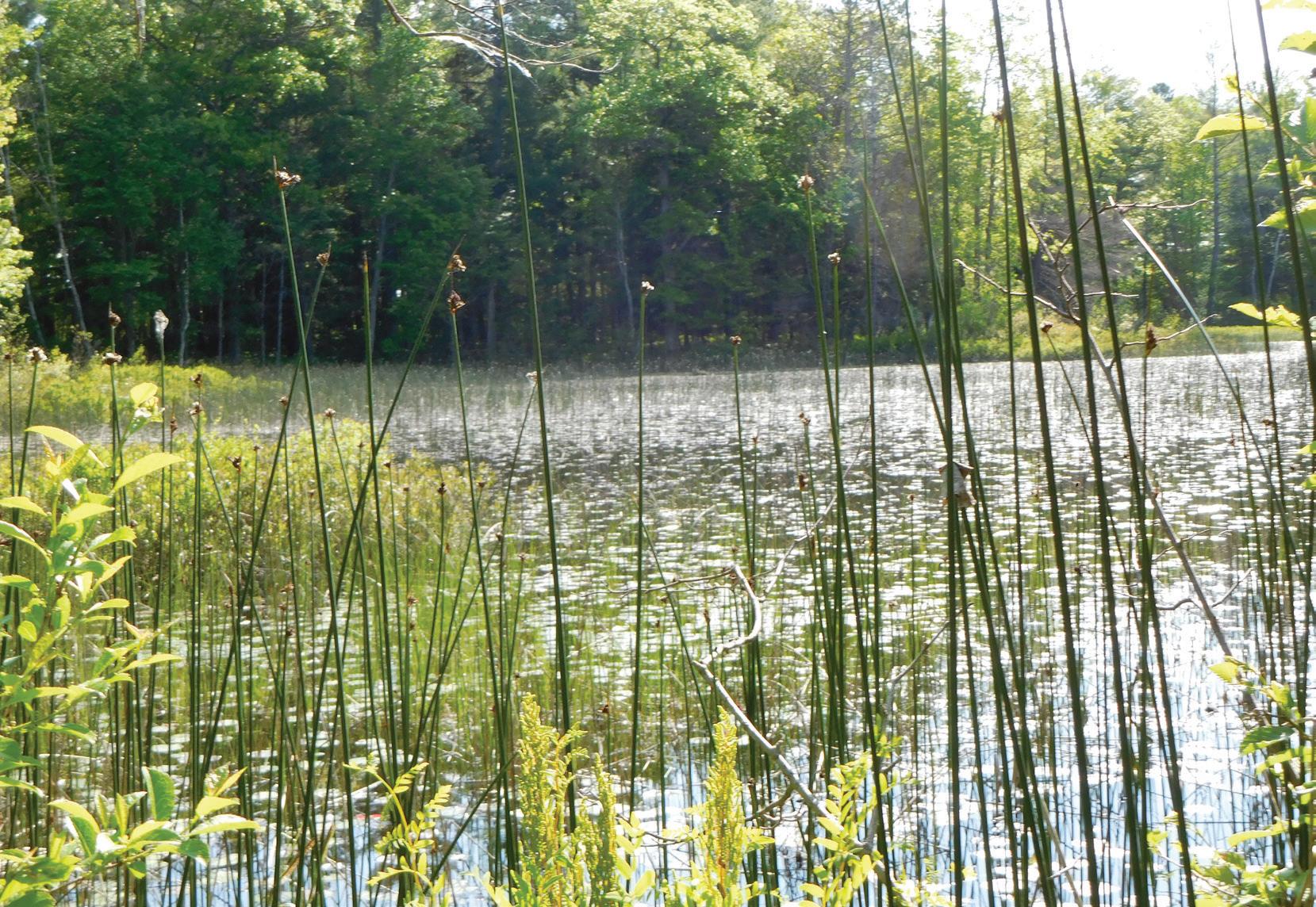
2. Emergent Marsh | Marsh Group
As the name suggests, vegetation in this habitat “emerges” from shallow water, which is usually at least six inches deep. This habitat is dominated by grass-like plants such as bulrushes and sedges and flowering plants such as water lilies. If you visit an emergent marsh during the growing season, you will see the tops of these plants rising above the water’s surface.
The best example of an emergent marsh at the preserve is along of the trail to the loop to the north west of Grass Lake. You may also notice emergent marsh species like cattail in deeper water along Grass Lake and in connected wetlands.
Emergent marsh plants provide habitat to a wide range of aquatic invertebrates that support various species of fish, amphibians, reptiles, waterfowl and mammals. Water levels often fluctuate in these dynamic habitats due to climatic conditions and beaver activity. Over time, emergent marshes can transition into other wetland types depending on water levels.
For a visual diagram of this habitat type, see page 10.
Upper Manistee Headwaters: The Milock Family Preserve | Wetland Types 16
PHOTO: TALULA FOOTE
Emergent Marsh Plant Species
SUBMERGENT PLANTS
Bladderworts (Utricularia cornuta, U. gibba, U. intermedia, U. resupinata and U. vulgaris)
Bulrush Species (Schoenoplectus spp)
Coontail (Ceratophyllum demersum)
Muskgrasses (Chara spp.)
Naiads (Najas flexilis and others)
Pondweeds (Potamogeton spp.)
ROOTED FLOATING-LEAVED PLANTS
Pondweeds (Potamogeton spp.)
Sweet-scented Waterlily (Nymphaea odorata)
Water-shield (Brasenia schreberi)
Yellow Pond Lilies (Nuphar advena and N. variegata)
NON-ROOTED FLOATING PLANTS
Great Duckweed (Spirodela polyrhiza)
Small Duckweed (Lemna minor)
EMERGENT PLANTS GRAMINOIDS
Hardstem Bulrush (Schoenoplectus acutus)
Manna Grasses (Glyceria borealis, G. canadensis and G. striata)
Sedges (Carex comosa, C. lacustris, C. lasiocarpa, C. oligosperma, C. stricta, and others)
Softstem Bulrush (Schoenoplectus tabernaemontani)
Spike-rushes (Eleocharis spp.)
Three-way Sedge (Dulichium arundinaceum)*
FORBS
Arrowheads (Sagittaria spp.)
Broad-leaved Cattail (Typha latifolia)*
Bur-reeds (Sparganium spp.)*
Pickerel-weed (Pontederia cordata)
Swamp Loosestrife (Decodon verticillatus)*
FERNS
Marsh Fern (Thelypteris palustris)
*Indicator species featured in the section 2 of this guide
17 GTRLC.ORG

3. Northern Wet Meadow | Marsh Group
This open habitat occurs in shallow soils where land floods for part of the growing season, such as along the edges of lakes, ponds and streams. At the preserve, this habitat type is found near the north branch of the Manistee River and in isolated depressions where sedges survive fluctuating water levels.
Northern wet meadows usually border other wetland communities and are often part of large wetland complexes. You can recognize this community by its abundance of grass-like sedges growing among forbs (wildflowers). Tussock sedge (Carex stricta), a plant that builds mounds that provide roosting platforms as water levels shift, is particularly present in a northern wet meadow. These mounds are sometimes three feet high, providing refuge for insects like ants, which in turn provides critical protein sources for secretive marsh birds like rails and bitterns. These and other wildlife are in decline due to factors like habitat loss, altered hydrology and invasive plants.
For a visual diagram of this habitat type, see page 10.
Upper Manistee Headwaters: The Milock Family Preserve | Wetland Types 18
PHOTO: DAVID FOOTE
Northern Wet Meadow Plant Species
GRAMINOIDS
Blue-joint (Calamagrostis canadensis)*
Fowl Meadow Grass (Poa palustris)
Green Bulrush (Scirpus atrovirens)
Marsh Wild-timothy (Muhlenbergia glomerata)
Rattlesnake Grass (Glyceria canadensis)
Sedges (Carex lacustris, C. lasiocarpa, C. stricta, C. utriculata, and others)*
Spike-rush (Eleocharis erythropoda and E. palustris)
Twig-rush (Cladium mariscoides)
FORBS
Arrowhead Species (Sagittaria spp)
Bedstraw Species (Galium spp)
Blue Vervain (Verbena hastata)
Broad-leaved Cat-tail (Typha latifolia)
Canada Goldenrod (Solidago canadensis)
Cardinal Flower (Lobelia cardinalis)
Common Boneset (Eupatorium perfoliatum)
Common Skullcap (Scutellaria galericulata)
Common Water Horehound (Lycopus americanus)
Grass-leaved Goldenrod (Euthamia graminifolia)
Great Water Dock (Rumex orbiculatus)
Jewelweed (Impatiens capensis)
Joe-pye-weed (Eutrochium maculatum)*
Swamp Milkweed (Asclepias incarnata)*
Marsh Bellflower (Campanula aparinoides)
Marsh Cinquefoil (Comarum palustre)
Marsh Pea (Lathyrus palustris)
Marsh St. John’s-wort (Triadenum fraseri)
Northern Blue Flag Iris (Iris versicolor)
Northern Bugle Weed (Lycopus uniflorus)
Panicled Aster (Symphyotrichum lanceolatum)
Purple Meadow-rue (Thalictrum dasycarpum)
Rough Goldenrod (Solidago rugosa)
Side-flowering Aster (Symphyotrichum lateriflorum)
Swamp Candles (Lysimachia terrestris)
Swamp Goldenrod (Solidago patula)
Tall Goldenrod (Solidago altissima)
Tufted Loosestrife (Lysimachia thyrsiflora)
Water-hemlocks (Cicuta bulbifera and C. maculata)
Water Smartweed (Persicaria amphibia)
Wild Mint (Mentha canadensis)
FERNS
Marsh Fern (Thelypteris palustris)
Sensitive Fern (Onoclea sensibilis)
SHRUBS
Bog Birch (Betula pumila)
Meadowsweet (Spiraea alba)
Red-osier Dogwood (Cornus sericea)
Sweet Gale (Myrica gale)
Tag Alder (Alnus incana)
Willows (Salix spp.)
*Indicator species featured in the section 2 of this guide
19 GTRLC.ORG

4. Bog | Bog Group
Bogs are open, wetland habitats defined by acidic, saturated peat and large amounts of mosses and Ericaceae (heath) shrubs. They often have a floating mat of vegetation and sparse tree cover, typically less than 10%. Leatherleaf and sphagnum moss are the dominant plant species, and when combined with other factors, their presence usually indicates a true bog.
Most northern bogs receive water from precipitation rather than from groundwater or streams, resulting in less mineral and nutrient content available for plants to use. This slows the decomposition of organic matter and—in addition to high acidity, extreme temperatures and drought—creates harsh growing conditions. Certain insectivorous plants, such as pitcher plant (Sarracenia purpurea) and sundews (Drosera spp.), have developed unique adaptations to survive such formidable conditions by trapping and consuming insects to supplement missing soil nutrients.
Many of the preserve’s kettle lakes contain bogs, some with submergent marsh habitat in the center with marshes or shrub habitat surrounding them.
For a visual diagram of this habitat type, see page 11.
Upper Manistee Headwaters: The Milock Family Preserve | Wetland Types 20
PHOTO: ANGIE BOUMA
Bog Plant Species
GRAMINOIDS
Cotton Grasses (Eriophorum virginicum and others)
Few-flower Sedge (Carex pauciflora)
Few-seed Sedge (Carex oligosperma)
White Beak-rush (Rhynchospora alba)
Wiregrass Sedge (Carex lasiocarpa)
Wool-grass (Scirpus cyperinus)
FORBS
Arrowgrass (Scheuchzeria palustris)*
Bog Bladderwort (Utricularia geminiscapa)
Bog Buckbean (Menyanthes trifoliata)
Bog Goldenrod (Solidago uliginosa)
Grass-pink (Calopogon tuberosus)*
Horned Bladderwort (Utricularia cornuta)
Marsh Cinquefoil (Comarum palustre)
Pink Lady-slipper (Cypripedium acaule)
Pitcher Plant (Sarracenia purpurea)*
Spatulate-leaved Sundew (Drosera intermedia)
Rose Pogonia (Pogonia ophioglossoides)
Round-leaved Sundew (Drosera rotundifolia)
White Fringed Orchid (Platanthera blephariglottis)
Wild Calla (Calla palustris)
MOSSES
Sphagnum Mosses (Sphagnum spp.)
FERNS
Cinnamon Fern (Osmundastrum cinnamomeum)
Marsh Fern (Thelyptris palustris)
SHRUBS
Black Chokeberry (Aronia prunifolia)
Bog Laurel (Kalmia polifolia)
Bog Rosemary (Andromeda glaucophylla)
Bog Willow (Salix pedicellaris)
Buttonbush (Cephalanthus occidentalis)
Canada Blueberry (Vaccinium myrtilloides)
Labrador Tea (Rhododendron groenlandicum)
Large Cranberry (Vaccinium macrocarpon)
Leatherleaf (Chamaedaphne calyculata)*
Low Sweet Blueberry (Vaccinium angustifolium)
Mountain Holly (Ilex mucronata)
Small Cranberry (Vaccinium oxycoccos)
Smooth Highbush Blueberry (Vaccinium corymbosum)
Wild-raisin (Viburnum cassinoides)
Winterberry (Ilex verticillata)
TREES
Black Spruce (Picea mariana)
Jack Pine (Pinus banksiana)
Red Maple (Acer rubrum)
Red Pine (Pinus resinosa)
Tamarack (Larix laricina)
White Pine (Pinus strobus)
*Indicator species featured in the section 2 of this guide
21 GTRLC.ORG

5. Muskeg | Bog Group
This unique peatland habitat, sometimes referred to as a “tree’d bog,” features an acidic substrate of mosses and shares many similarities to a bog. Yet, unlike typical bogs, which have less than 10% tree cover, muskegs host stunted conifers covering 10-25% of the area. Their acidic conditions result in the short stature of the trees, which generally reach only 2-3 meters tall.
This successional habitat is usually found within large habitat complexes in former lake plains left by retreating glaciers. However, at the preserve, small examples of muskegs occur within the property’s kettle bogs. This rare habitat is a result of succession and vegetation growth, which created a floating bog mat capable of supporting trees. The preserve is home to about seven acres of inaccessible muskeg habitat which are located in the middle of bogs and surrounded by a deep flow of water.
For a visual diagram of this habitat type, see page 11.
Upper Manistee Headwaters: The Milock Family Preserve | Wetland Types 22
PHOTO: ANGIE BOUMA
Muskeg Plant Species
GRAMINOIDS
Tawny cotton-grass (Eriophorum virginicum)
Three-way Sedge (Dulichium arundinaceum)
White Beak-rush (Rhynchospora alba)
Wiregrass Sedge (Carex lasiocarpa)
FORBS
Bog Buckbean (Menyanthes trifoliata)
Common Bog Arrowgrass (Triglochin maritima)
Goldthread (Coptis trifolia)
Pitcher Plant (Sarracenia purpurea)
Round-leaved Sundew (Drosera rotundifolia)
MOSSES
Sphagnum Mosses (Sphagnum spp.)
SHRUBS
Bog Rosemary (Andromeda glaucophylla)
Bog Willow (Salix pedicellaris)
Large Cranberry (Vaccinium macrocarpon)
Leatherleaf (Chamaedaphne calyculata)
Winterberry (Ilex verticillata)
TREES
Black Spruce (Picea mariana)
Tamarack (Larix laricina)
White Pine (Pinus strobus)
*Indicator species featured in the section 2 of this guide
23 GTRLC.ORG

6. Poor Fen | Fen Group
These grassy, open wetlands are relatively rare in Michigan, occurring in kettle depressions and along rivers and lake shores. If you walk on them (please note, hiking off-trail at the preserve is discouraged!), you may notice they have a springy feel under your feet.
Poor fens are prone to flooding, feature acidic, saturated peat and are moderately influenced by groundwater. As a result, they are capable of supporting species that require more minerals and nutrients. You will primarily see sedge species in a poor fen and a few small, scattered evergreen shrubs and conifer trees. Dominant plants include wiregrass sedge (Carex lasiocarpa) and few-seed sedge (Carex oligosperma), which form floating mats of vegetation above the water’s surface. Poor fens provide valuable habitat for shrews, beavers, mink, voles, reptiles and many bird species.
As mentioned earlier, the type of habitat that exists in an area at a given time can be influenced by water levels and natural disturbances. For instance, if the water table is low for long enough, a poor fen could convert into a northern shrub thicket. Likewise, flooding could lead to the transition of a fen into a marsh.
For a visual diagram of this habitat type, see page 12.
Upper Manistee Headwaters: The Milock Family Preserve | Wetland Types 24
PHOTO: RICK KANE
Poor Fen Plant Species
GRAMINOIDS
Cotton-grasses (Eriophorum angustifolium, E. vaginatum and E. virginicum)
Sedges (Carex chordorrhiza, C. lasiocarpa, C. limosa, C. oligosperma, C. pauciflora and others)*
Three-way Sedge (Dulichium arundinaceum)
Tufted Bulrush (Trichophorum cespitosum)
Twig-rush (Cladium mariscoides)
White Beak-rush (Rhynchospora alba)*
FORBS
Arrowgrass (Scheuchzeria palustris)
Bladderworts (Utricularia cornuta and U. intermedia)
Bog Buckbean (Menyanthes trifoliata)
Common Bog Arrow-grass (Triglochin maritima)
False Mayflower (Maianthemum trifolium)
Grass-leaved Goldenrod (Euthamia graminifolia)
Marsh Cinquefoil (Comarum palustre)
Northern Blue Flag Iris (Iris versicolor)*
Pitcher Plant (Sarracenia purpurea)
Ringed Willow-herb (Epilobium ciliatum)
Round-leaved Sundew (Drosera rotundifolia)
Spatulate-leaved Sundew (Drosera intermedia)
Swamp Candles (Lysimachia terrestris)
MOSSES
Sphagnum Mosses (Sphagnum spp.)
SHRUBS
Black Chokeberry (Aronia prunifolia)
Bog Birch (Betula pumila)
Bog Laurel (Kalmia polifolia)
Bog Rosemary (Andromeda glaucophylla)
Bog Willow (Salix pedicellaris)*
Labrador Tea (Rhododendron groenlandicum)
Large Cranberry (Vaccinium macrocarpon)
Leatherleaf (Chamaedaphne calyculata)
Meadowsweet (Spiraea alba)
Mountain Holly (Ilex mucronata)
Small Cranberry (Vaccinium oxycoccos)
Sweet Gale (Myrica gale)
Wild-raisin (Viburnum cassinoides)
TREES
Black Spruce (Picea mariana)
Jack Pine (Pinus banksiana)
Tamarack (Larix laricina)
White Pine (Pinus strobus)
*Indicator species featured in the section 2 of this guide
25 GTRLC.ORG

7. Northern Shrub Thicket | Shrub Wetland Group
If you’re in an area of the preserve that feels like a mangrove swamp, you’re likely in a northern shrub thicket or “tag alder swamp.” At the Upper Manistee Headwaters Preserve, this wetland habitat forms extensive shrub forests along the streams, lakes and along the edges of bogs and fens.
A keystone species, tag alder supports the habitat’s entire ecosystem. The shrub’s unique adaptation provides a distinct advantage; its roots’ symbiotic relationship with bacteria enables the plant to take nitrogen from the air and transfer it into the soil. Thus, tag alder can grow in stagnant waters with a limited nitrogen supply.
This wetland community has nutrient-rich, wet-to-moist soils and frequently floods in the spring. As water levels fluctuate in lakes and streams, open wetlands often convert to northern shrub thickets. The dense growth of tag alder and other shrubs helps slow water and improve water quality by trapping sediment and erosion.
For a visual diagram of this habitat type, see page 12.
Upper Manistee Headwaters: The Milock Family Preserve | Wetland Types 26
PHOTO: DEREK BRINKS
Northern Shrub Thicket Plant Species
GRAMINOIDS
Blue-joint (Calamagrostis canadensis)
Fowl Manna Grass (Glyceria striata)
Fowl Meadow Grass (Poa palustris)
Green Bulrush (Scirpus atrovirens)
Lake Sedge (Carex lacustris)
Rattlesnake Grass (Glyceria canadensis)
Retrorse Sedge (Carex retrorsa)
Tussock Sedge (Carex stricta)
FORBS
Canada Goldenrod (Solidago canadensis)
Common Boneset (Eupatorium perfoliatum)
Common Skullcap (Scutellaria galericulata)
Great Water Dock (Rumex orbiculatus)
Jewelweed (Impatiens capensis)
Joe-pye-weed (Eutrochium maculatum)
Late Goldenrod (Solidago gigantea)
Mad-dog Skullcap (Scutellaria lateriflora)
Marsh Bellflower (Campanula aparinoides)
Marsh Cinquefoil (Comarum palustre)
Marsh-marigold (Caltha palustris)
Northern Blue Flag Iris (Iris versicolor)
Northern Bugle Weed (Lycopus uniflorus)
Panicled Aster (Symphyotrichum lanceolatum)
Purple Meadow-rue (Thalictrum dasycarpum)
Rough Bedstraw (Galium asprellum)
Rough Goldenrod (Solidago rugosa)
Swamp Aster (Symphyotrichum puniceum)
Swamp Milkweed (Asclepias incarnata)
Wild Calla (Calla palustris)
Wild Mint (Mentha canadensis)
FERNS
Cinnamon Fern (Osmunda cinnamomea)
Marsh Fern (Thelypteris palustris)
Royal Fern (Osmunda regalis)*
Sensitive Fern (Onoclea sensibilis)
FERN ALLIES
Common Horsetail (Equisetum arvense)
SHRUBS
American Highbush-cranberry (Viburnum trilobum)
Black Chokeberry (Aronia prunifolia)
Bog birch (Betula pumila)
Buttonbush (Cephalanthus occidentalis)*
Dwarf raspberry (Rubus pubescens)
Meadowsweet (Spiraea alba)
Red-osier Dogwood (Cornus sericea)
Silky Dogwood (Cornus amomum)
Swamp Dewberry (Rubus hispidus)
Swamp Rose (Rosa palustris)
Sweet Gale (Myrica gale)
Tag Alder (Alnus incana)*
Wild-raisin (Viburnum cassinoides)
Wild Red Raspberry (Rubus strigosus)
Willows (Salix bebbiana, S. discolor, S. exigua, S. petiolaris)
Winterberry (Ilex verticillata)*
TREES
Balsam Fir (Abies balsamea)
Black Ash (Fraxinus nigra)
Black Spruce (Picea mariana)
Northern White-cedar (Thuja occidentalis)
Red Maple (Acer rubrum)
Tamarack (Larix laricina)
White Pine (Pinus strobus)
*Indicator species featured in the section 2 of this guide
27 GTRLC.ORG
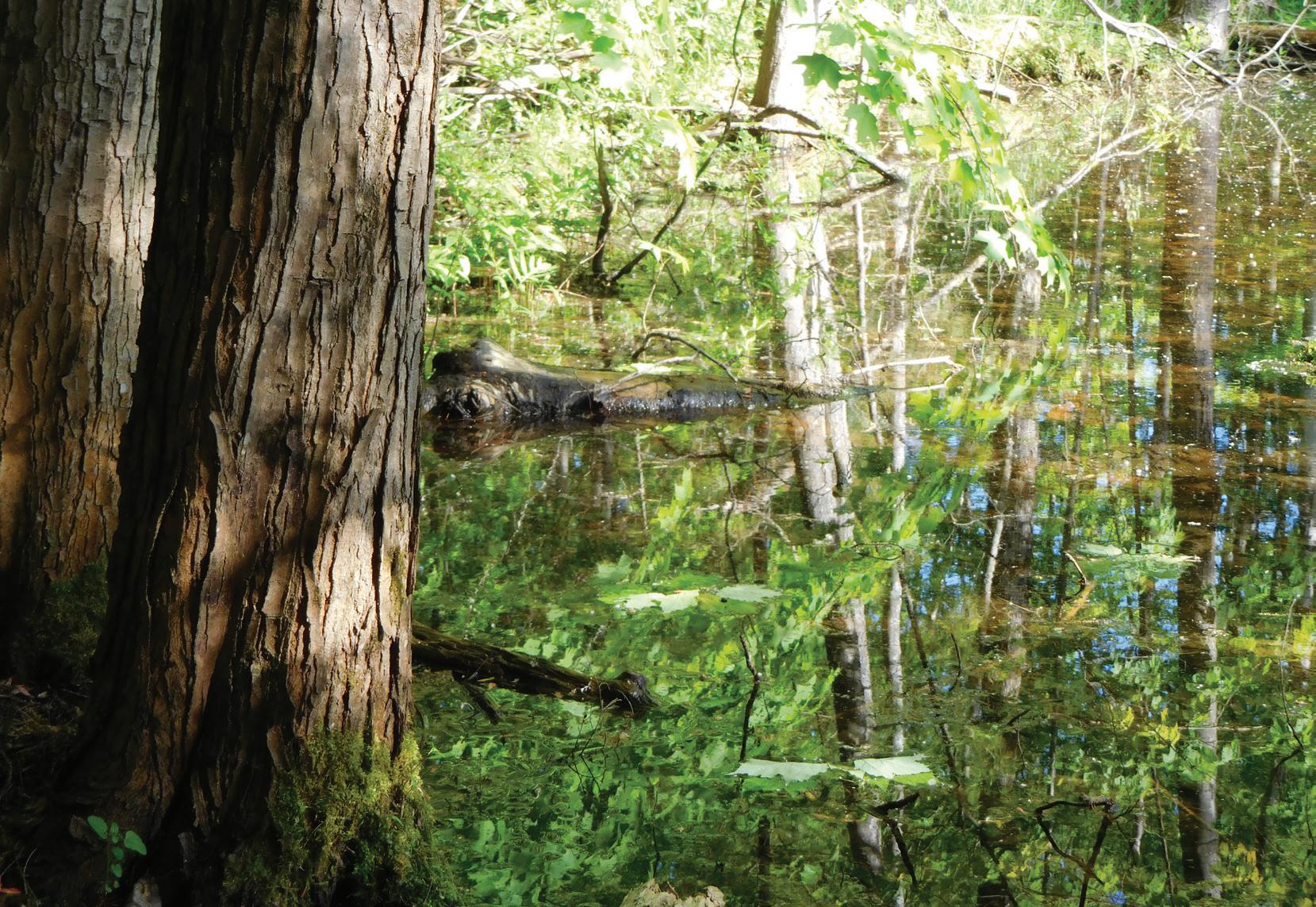
8. Hardwood Conifer Swamp | Forested Wetland Group
Hardwood conifer swamps generally have less saturated conditions than other forested wetlands and are dominated by a mix of northern hardwoods and lowland conifers. Hemlock (Tsuga canadensis) is the primary overstory canopy tree, in addition to yellow birch (Betula alleghaniensis), white birch (Betula papyrifera) and ash trees (Fraxinus spp.). On the property, this wetland habitat type is found along narrow habitat gradients along the west side of Grass Lake.
For a visual diagram of this habitat type, see page 13.
Upper Manistee Headwaters: The Milock Family Preserve | Wetland Types 28
PHOTO: TALULA FOOTE
Hardwood Conifer Swamp Plant Species
GRAMINOIDS
Bluejoint Grass (Calamagrostis canadensis)
Fowl Manna Grass (Glyceria striata)
Fowl Meadow Grass (Poa palustris)
Sedges (Carex crinita, C. disperma, C. gracillima, C. intumescens, C. lacustris, C. stricta, and others)
Virginia Wild-rye (Elymus virginicus)
FORBS
Beggar-ticks (Bidens spp.)
Bluebead Lily (Clintonia borealis)
Calico Aster (Symphyotrichum lateriflorum)
Canada Mayflower (Maianthemum canadense)
Jack-in-the-pulpit (Arisaema triphyllum)
Gay-wings (Polygala paucifolia)
Goldenrods (Solidago patula, S. rugosa, and others)
Goldthread (Coptis trifolia)
Marsh-marigold (Caltha palustris)
Northern Bugle Weed (Lycopus uniflorus)
Partridge Berry (Mitchella repens)
Small Enchanter’s-nightshade (Circaea alpina)
Starflower (Trientalis borealis)*
Swamp aster (Symphyotrichum puniceum)
Swamp Milkweed (Asclepias incarnata)
Twinflower (Linnaea borealis)
Violets (Viola spp.)
Virgin’s Bower (Clematis virginiana)
Water-parsnip (Sium suave)
Wild Sarsaparilla (Aralia nudicaulis)
Willow-herbs (Epilobium spp.)
MOSSES
Big Red Stem Moss (Pleurozium schreberi)
Callicladium Moss (Callicladium haldanianum)
Sphagnum Mosses (Sphagnum spp.)
FERNS
Cinnamon Fern (Osmunda cinnamomea)
New York Fern (Thelypteris noveboracensis)
Oak Fern (Gymnocarpium dryopteris)
Royal Fern (Osmunda regalis)
Sensitive Fern (Onoclea sensibilis)
Wood Ferns (Dryopteris spp.)
FERN ALLIES
Horsetails (Equisetum spp.)
WOODY VINES
Poison-ivy (Toxicodendron radicans)
Riverbank Grape (Vitis riparia)
Virginia Creeper (Parthenocissus quinquefolia)
SHRUBS
Alder-leaved Buckthorn (Rhamnus alnifolia)
Canadian Fly Honeysuckle (Lonicera canadensis)
Creeping Snowberry (Gaultheria hispidula)
Currant (Ribes spp.)
Dogwoods (Cornus spp.)
Dwarf Raspberry (Rubus pubescens)
Poison Sumac (Toxicodendron vernix)
Spicebush (Lindera benzoin)
Tag Alder (Alnus incana)
Winterberry (Ilex verticillata)
TREES
American Elm (Ulmus americana)
Balsam Fir (Abies balsamea)
Basswood (Tilia americana)
Black Ash (Fraxinus nigra)
Black Spruce (Picea mariana)
Blue Beech (Carpinus caroliniana)
Green Ash (Fraxinus pennsylvanica)
Hemlock (Tsuga canadensis)*
Mountain Maple (Acer spicatum)
Northern White-cedar (Thuja occidentalis)
Paper Birch (Betula papyrifera)
Red Maple (Acer rubrum)
Tamarack (Larix laricina)
White Pine (Pinus strobus)
Yellow Birch (Betula alleghaniensis)*
*Indicator species featured in the section 2 of this guide
29 GTRLC.ORG

9. Poor Conifer Swamp | Forested Wetland Group
The term “swamp” refers to forested wetlands. A poor conifer swamp is characterized by slow-growing coniferous trees like black spruce (Picea mariana) and tamarack (Larix laricina), along with sphagnum mosses and ericaceous shrubs. This habitat has acidic, organic peat soils and unlike a rich conifer swamp, it is not influenced by groundwater.
These nutrient-poor peatlands are typically found in the north, forming in the wettest of organic soils. As an open water area is slowly colonized by a bog mat, tamarack is the first tree species to grow. Black spruce follows soon after, as the peat becomes more stable.
For a visual diagram of this habitat type, see page 13.
Upper Manistee Headwaters: The Milock Family Preserve | Wetland Types 30
PHOTO: NOAH JURIK
Poor Conifer Swamp Plant Species
GRAMINOIDS
Sedges (Carex oligosperma, C. pauciflora, C. trisperma, and others)
Tawny Cotton-grass (Eriophorum virginicum)
Wool-grass (Scirpus cyperinus)
FORBS
Bluebead Lily (Clintonia borealis)
Canada Mayflower (Maianthemum canadense)
False Mayflower (Maianthemum trifolium)
Goldthread (Coptis trifolia)
Northern Blue Flag Iris (Iris versicolor)
Pink Lady-slipper (Cypripedium acaule)
Pitcher-plant (Sarracenia purpurea)
Round-leaved Sundew (Drosera rotundifolia)
Starflower (Trientalis borealis)
Wild Calla (Calla palustris)
MOSSES
Big Red Stem Moss (Pleurozium schreberi)
Pohlia Moss (Pohlia nutans)
Ribbed bog Moss (Aulacomnium palustre)
Sphagnum Mosses (Sphagnum spp.)
FERNS
Marsh Fern (Thelyptris palustris)
Royal Fern (Osmunda regalis)
Sensitive Fern (Onoclea sensibilis)
SHRUBS
Black Chokeberry (Aronia prunifolia)
Blueberries (Vaccinium angustifolium, V. corymbosum, and V. myrtilloides)
Bog Laurel (Kalmia polifolia)
Bog Rosemary (Andromeda glaucophylla)
Bunchberry (Cornus canadensis)
Creeping Snowberry (Gaultheria hispidula)
Huckleberry (Gaylussacia baccata)
Labrador Tea (Rhododendron groenlandicum)*
Leatherleaf (Chamaedaphne calyculata)
Mountain Holly (Ilex mucronata)
Small Cranberry (Vaccinium oxycoccos)
Wild-raisin (Viburnum cassinoides)
Winterberry (Ilex verticillata)
Wintergreen (Gaultheria procumbens)
TREES
Balsam Fir (Abies balsamea)
Black Spruce (Picea mariana)
Jack Pine (Pinus banksiana)
Paper Birch (Betula papyrifera)
Tamarack (Larix laricina)*
White Pine (Pinus strobus)*
*Indicator species featured in the section 2 of this guide
31 GTRLC.ORG
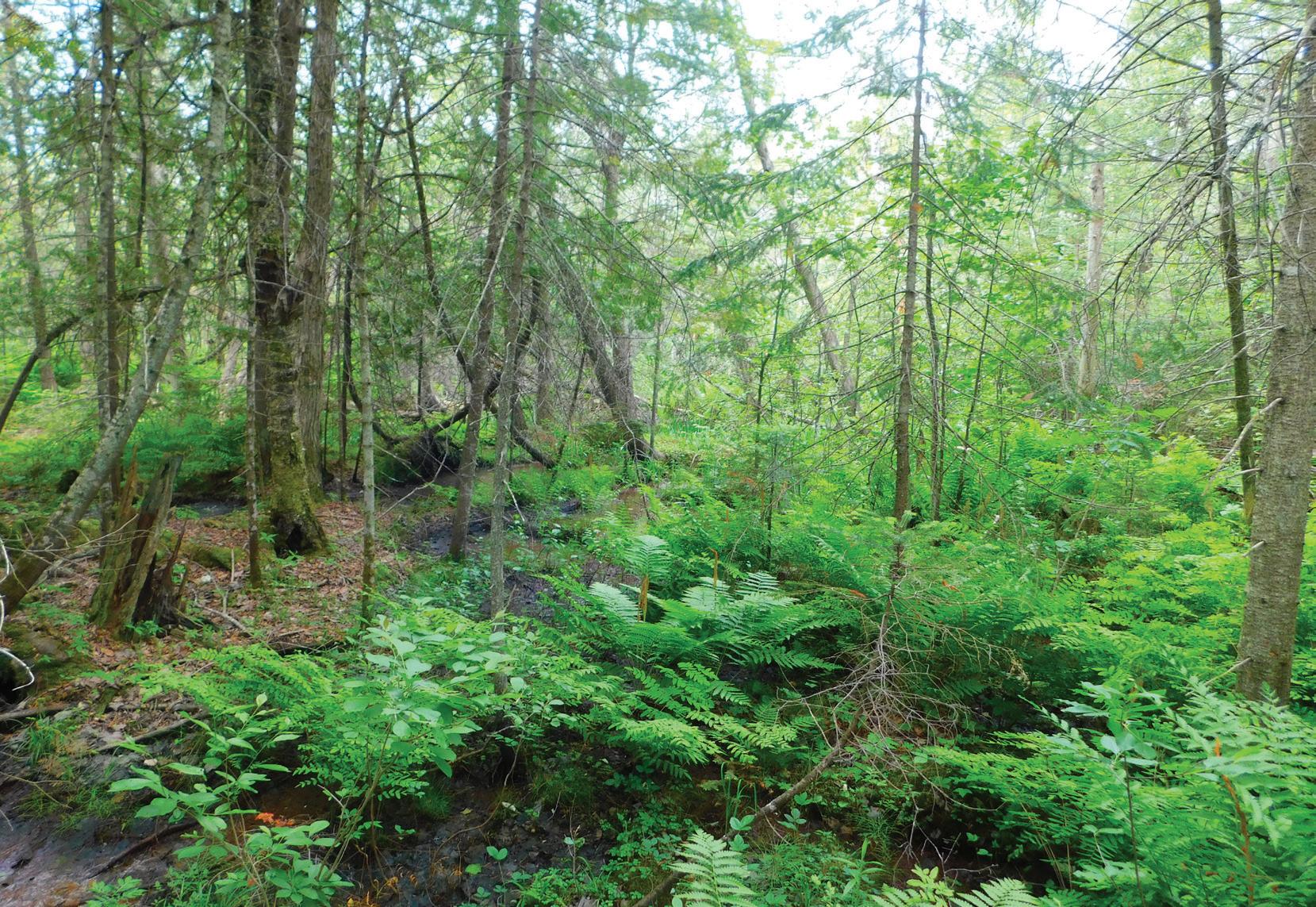
10. Rich Conifer Swamp | Forested Wetland Group
Sometimes simply called “cedar swamps,” this forested wetland type has a unique microtopography and is dominated by northern white cedar (Thuja occidentalis). Cedar forms dense canopies that limit the amount of light available for other species.
Due to the high water table, trees are shallow-rooted and susceptible to blowdown, creating “tip-ups” resulting in many dead snags that create openings for forbs and shrubs to grow.
In addition to northern white cedar, this habitat contains a mix of balsam fir (Abies balsamea), red maple (Acer rubrum), yellow birch (Betula alleghaniensis) and a diverse understory. This habitat’s unique microclimate and complex community structure make it an area of significant biodiversity for the preserve. Hummocks, which result from overturned trees, contribute to the swamp’s complex micro-topography. Some interesting herbaceous species include three-leaf Solomon-seal (Smilicina trifolia) and abundant populations of cinnamon fern (Osmunda cinnamomea).
For a visual diagram of this habitat type, see page 13.
Upper Manistee Headwaters: The Milock Family Preserve | Wetland Types 32
PHOTO: DAVID FOOTE
Rich Conifer Swamp Plant Species
GRAMINOIDS
Sedges (Carex oligosperma, C. pauciflora, C. trisperma, and others)
Tawny Cotton-grass (Eriophorum virginicum)
Wool-grass (Scirpus cyperinus)
FORBS
Bluebead Lily (Clintonia borealis)
Canada Mayflower (Maianthemum canadense)*
Club-spur Orchid (Platanthera clavellata)
Common Skullcap (Scutellaria galericulata)
False Mayflower (Maianthemum trifolium)
Fragrant Bedstraw (Galium triflorum)
Gay-wings (Polygala paucifolia)
Goldthread (Coptis trifolia)
Jack-in-the-pulpit (Arisaema triphyllum)
Jewelweed (Impatiens capensis)
Lady-slippers (Cypripedium spp.)
Mad-dog Skullcap (Scutellaria lateriflora)
Marsh-marigold (Caltha palustris)
Northern Blue Flag Iris (Iris versicolor)
Partridge Berry (Mitchella repens)
Pyrolas (Pyrola americana and P. asarifolia)
Small Enchanter’s-nightshade (Circaea alpina)
Starflower (Trientalis borealis)
Twinflower (Linnaea borealis)
Violets (Viola spp.)
Wild Sarsaparilla (Aralia nudicaulis)
Willow-herbs (Epilobium spp.)
MOSSES
Big Red Stem Moss (Pleurozium schreberi)
Calliergon Moss (Calliergon cordifolium)
Ribbed Bog Moss (Aulacomnium palustre)
Sphagnum Mosses (Sphagnum spp.)
FERNS
Cinnamon Fern (Osmunda cinnamomea)
Marsh Fern (Thelypteris palustris)
Oak Fern (Gymnocarpium dryopteris)
Sensitive Fern (Onoclea sensibilis)
Wood Ferns (Dryopteris spp.)
FERN ALLIES
Water Horsetail (Equisetum fluviatile)
Woodland Horsetail (Equisetum sylvaticum)
SHRUBS
Alder-leaved Buckthorn (Rhamnus alnifolia)
Blueberries (Vaccinium spp.)
Bunchberry (Cornus canadensis)
Canadian Fly Honeysuckle (Lonicera canadensis)*
Creeping Snowberry (Gaultheria hispidula)
Dogwood (Cornus spp.)
Dwarf Raspberry (Rubus pubescens)
Labrador Tea (Rhododendron groenlandicum)
Mountain Holly (Ilex mucronata)
Poison-ivy (Toxicodendron radicans)
Tag Alder (Alnus incana)
Winterberry (Ilex verticillata)
Wintergreen (Gaultheria procumbens)
TREES
American Elm (Ulmus americana)
Balsam Fir (Abies balsamea)
Balsam Poplar (Populus balsamifera)
Black Ash (Fraxinus nigra)
Black Spruce (Picea mariana)
Hemlock (Tsuga canadensis)
Northern White-cedar (Thuja occidentalis)*
Paper Birch (Betula papyrifera)
Quaking Aspen (Populus tremuloides)
Red Maple (Acer rubrum)
Tamarack (Larix laricina)
White Pine (Pinus strobus)
White Spruce (Picea glauca)
Yellow Birch (Betula alleghaniensis)
*Indicator species featured in the section 2 of this guide
33 GTRLC.ORG
SECTION 2: WETLAND HABITAT TYPE INDICATOR SPECIES
Upper Manistee Headwaters: The Milock Family Preserve | Plants 34
With 10 different types of wetland habitats, the Upper Manistee Headwaters Preserve is brimming with botanical diversity and notably—a near-complete lack of invasive species. These diverse, healthy wetlands contribute to the preserve’s impressively high Floristic Quality Index (FQI) score, which derives from numerous botanical inventories that determine the number of species growing on a property. The statewide average score is 20, with scores over 50 considered very rare and exceptionally significant. The Upper Manistee Headwaters Preserve registers a remarkable total FQI of 80.2!
Our staff ecologists have highlighted “indicator species” that help identify each wetland habitat found at the preserve. The flora included in this section does not comprise a comprehensive list of the preserve’s plant species but are notable species that help differentiate between habitat types.
Please note: Although it might be tempting, please do not pick the plants! Many of these species are uncommon outside the high-quality habitat of the Upper Manistee Headwaters Preserve, and some (like orchids) can take more than seven years to set seed.
What is a C Value?
A plant’s C value is short for its Coefficient of Conservatism value. Basically, on a 0-10 scale, this value indicates a plant’s preference for growing in a particular habitat type. For example, a plant with a lower C value can grow in multiple habitat types, whereas a plant with a high C value grows only in certain habitats.
All of the individual C values of the plants found on a property are then used to calculate a property’s Floristic Quality Index (FQI) score. This score is a good way to indicate that a high-quality habitat is functioning at natural levels, as the presence of certain plants suggests it is suitable for their growth.
35
GTRLC.ORG

American Bur-reed (Sparganium americanum)
Featured Wetland Type: Emergent Marsh
Best Season: Summer
C Value: 6
Sometimes called giant or broadfruit bur-reed, this tall and robust plant of the emergent zone can grow in water up to two feet deep. The large burs (made of fruit clusters) that give the plant its name look similar to a medieval mace.
Fun Fact:
This plant’s flowers are wind-pollinated, with the male flower clusters being separate and more highly elevated than the female. It also produces large seeds, which are able to float long distances, giving the plant an advantage in aquatic habitats.
Upper Manistee Headwaters: The Milock Family Preserve | Plants 36
PHOTO: ANGIE BOUMA
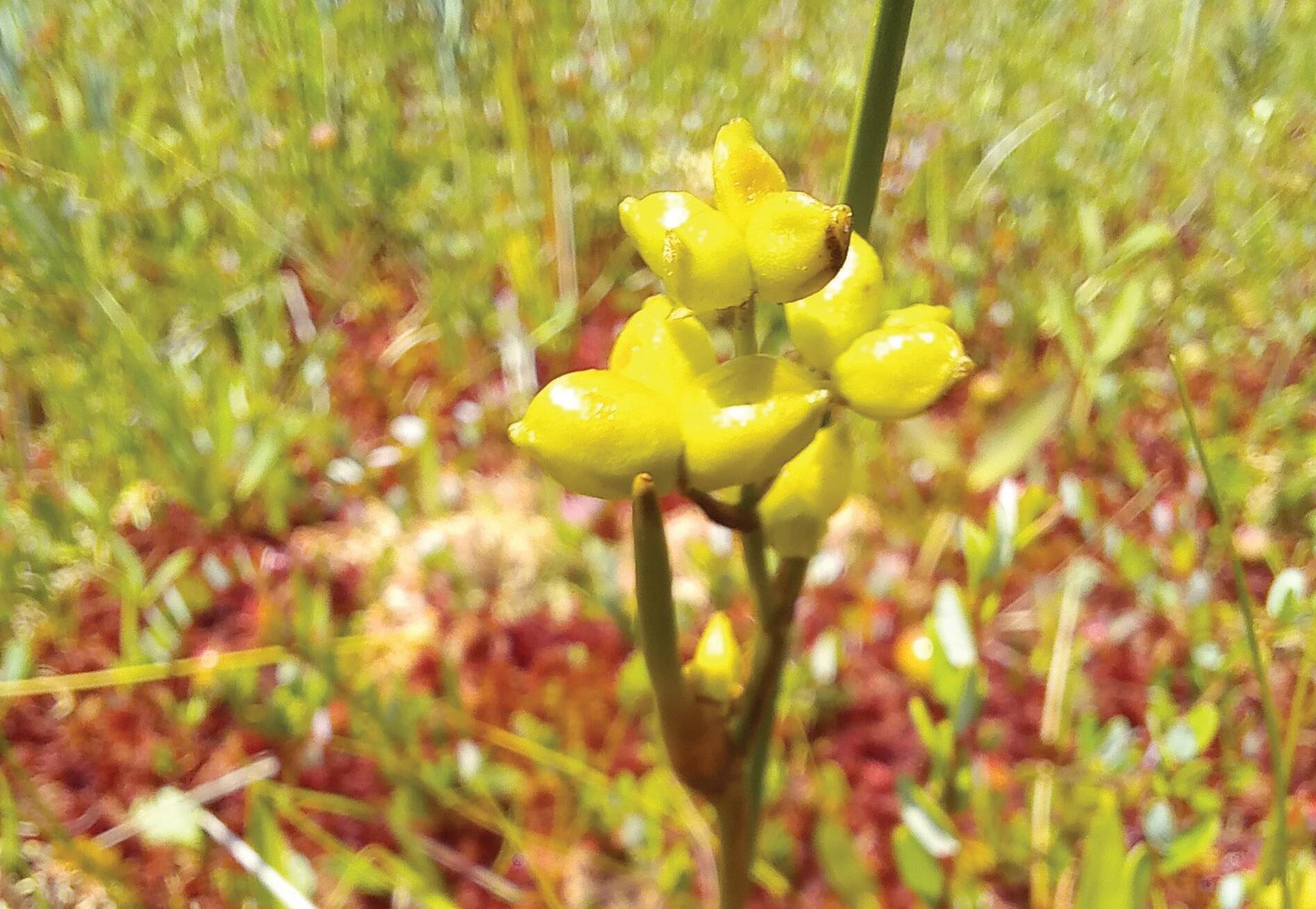
Arrowgrass (Scheuchzeria palustris)
Featured Wetland Type: Bog
Other Wetland Types: Poor Fen
Best Season: Summer
C Value: 10
This unique and hard-to-spot species has large pores at the top of its thick, tubular leaves. It requires open, sunny and acidic soils, and grows in bogs and fens. Everything about this plant is adapted to wetland conditions, including its large seed pods that float well to help distribute this species.
Fun Fact:
Despite its common name, arrowgrass is not a not a “true grass” in the Poa family, but a forb. It is the only species in the genus Scheuchzeria, which itself is the only genus in the family Scheuchzeriaceae.
37
PHOTO: ANGIE BOUMA
GTRLC.ORG
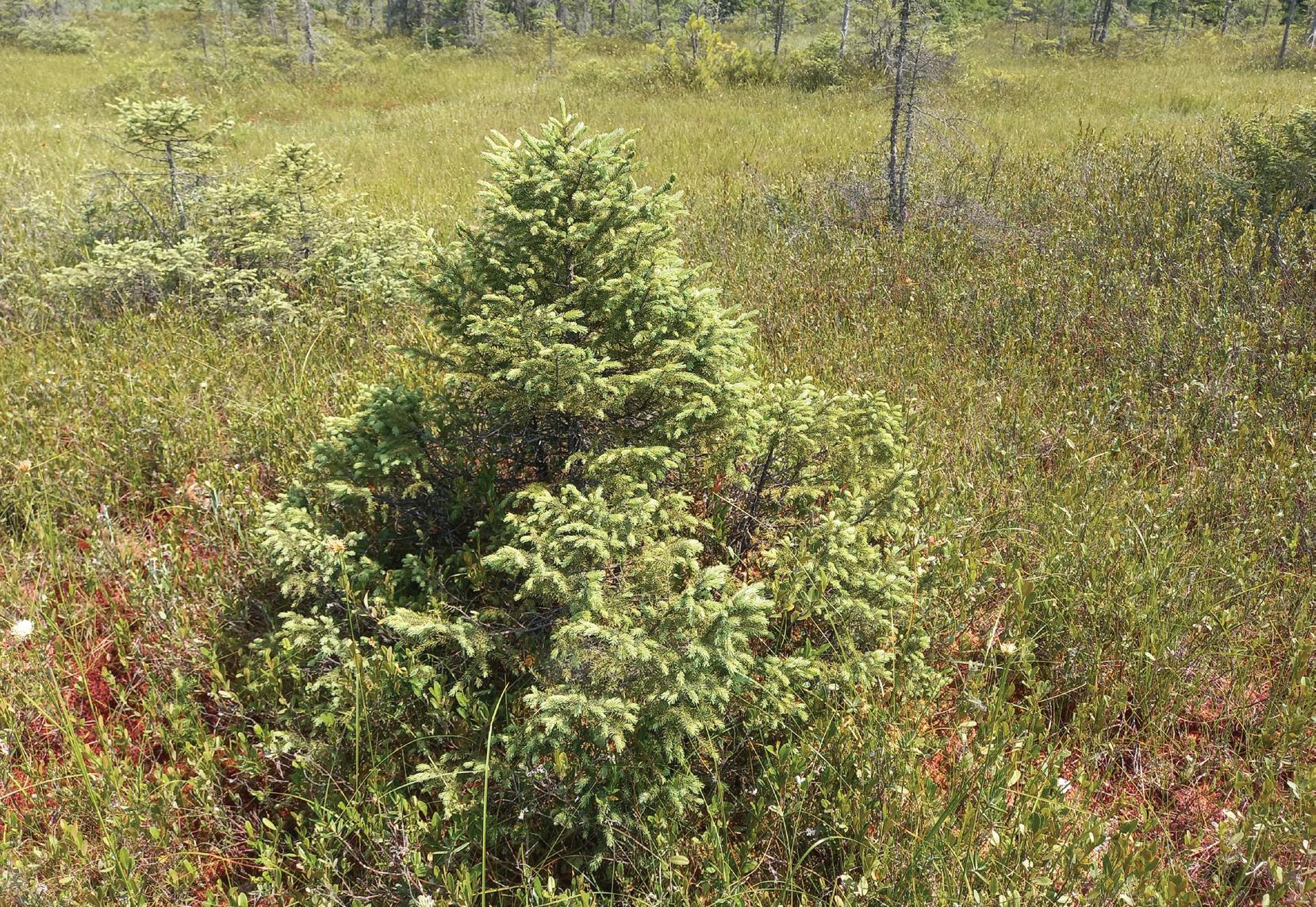
Black Spruce (Picea mariana)
Featured Wetland Types: Poor Conifer Swamp, Muskeg
Other Wetland Types: Bog, Poor Fen, Northern Shrub Thicket, Rich Conifer Swamp, Hardwood Conifer Swamp
Best Season: Year-round
C Value: 6
At the Upper Manistee Headwaters Preserve, black spruce trees are found growing on low mounds in bogs and poor fens. This conifer species is seen as an overstory tree in poor conifer swamps. Balsam fir (Abies balsamea) is another common species in these forested communities and looks similar to black spruce from a distance.
Fun Fact:
The hardy black spruce is one of the few trees that can grow in shallow soil above permafrost in northern habitats.
Upper Manistee Headwaters: The Milock Family Preserve | Plants 38
PHOTO: ANGIE BOUMA

Bladderwort (Utricularia vulgaris.)
Featured Wetland Type: Submergent Marsh
Other Wetland Types: Emergent Marsh, Bog
Best Season: Summer
C Value: 6
This remarkable, aquatic insectivorous plant has leaf-like stems submerged in water and many tiny, bladder-shaped leaves, which help keep the plant afloat and trap insects. It also produces showy, yellow flowers that grow above the water and have two lips, with a forward-facing spur on the lower lip, similar to snapdragons.
Fun Fact:
Out of the 11 bladderwort species in Michigan, at least five can be found in various habitats within the preserve. These interesting and beautiful plants grow in shallow to deep water, with the record (according to the University of Michigan Herbarium) being 15 feet deep!
39
PHOTO: ANGIE BOUMA
GTRLC.ORG
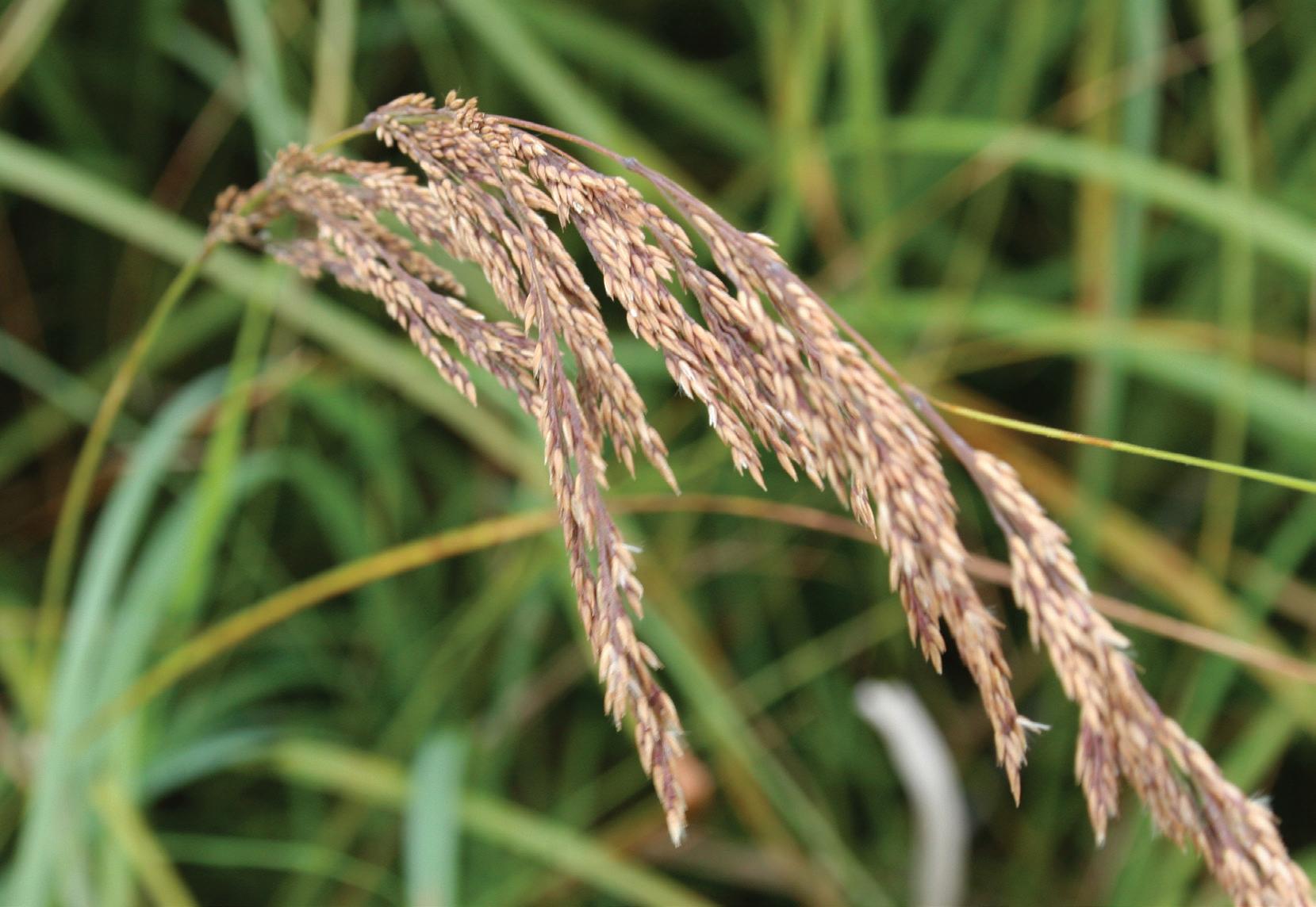
Blue Joint Grass (Calamagrostis canadensis)
Featured Wetland Type: Northern Wet Meadow
Other Wetland Types: Northern Shrub Thicket
Best Season: Summer-Fall
C Value: 3
Also called marsh reed grass, this important marsh plant grows up to five feet tall, with narrow blueish leaves growing in clumps. Along with Carex stricta, or tussock sedge, this plant is often considered the keystone species of northern wet meadows and is generally the most abundant species growing in this habitat.
Fun Fact:
This grass is a key component of northern wet meadows and is considered (along with tussock sedge and lake sedge) one of the “ecosystem engineers” at the preserve. Its thick growth restricts tree seedlings from establishing themselves and provides critical habitat for several birds.
Upper Manistee Headwaters: The Milock Family Preserve | Plants 40
PHOTO: ANGIE BOUMA
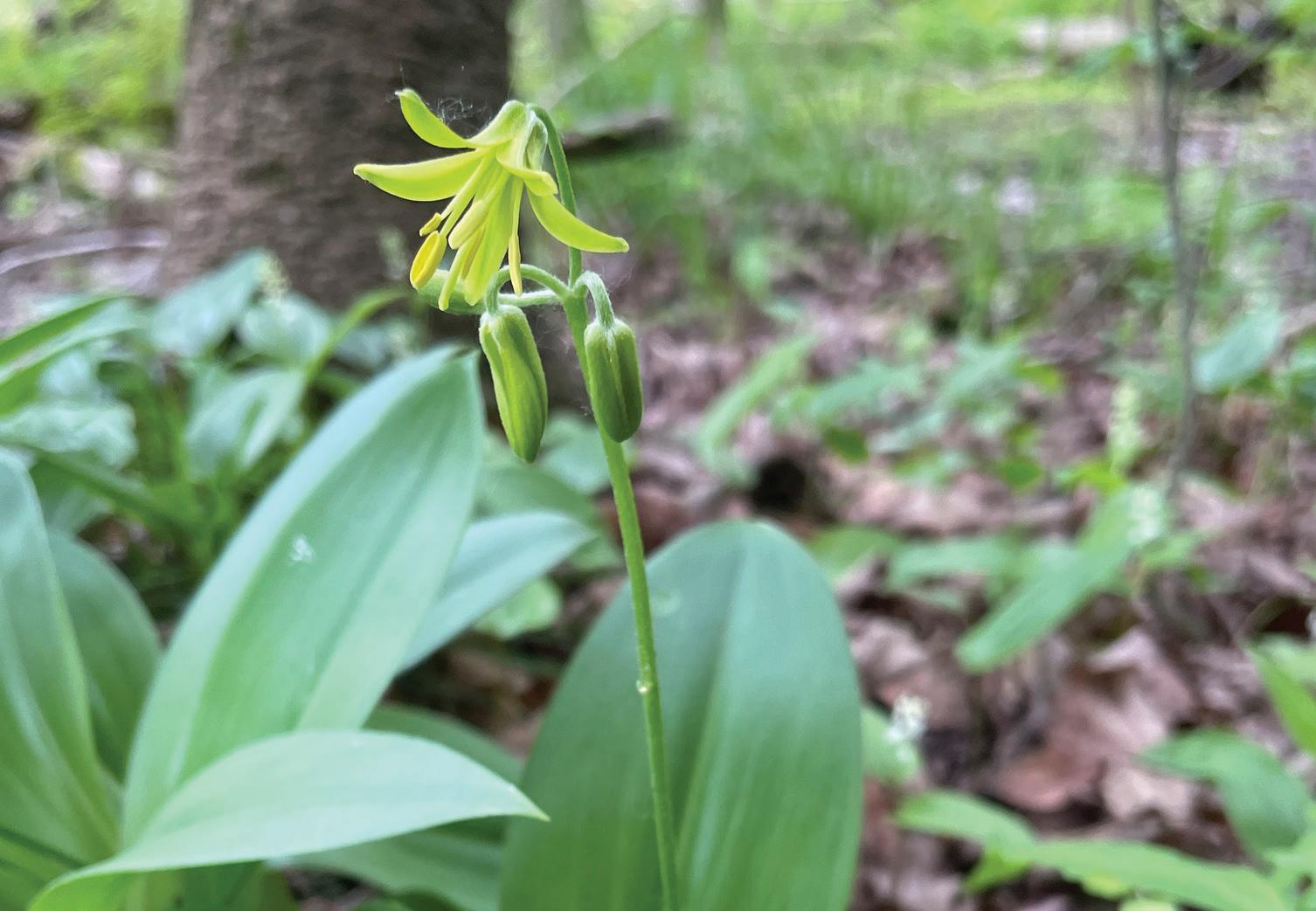
Blue-bead Lily (Clintonia borealis)
Featured Wetland Type: Hardwood Conifer Swamp
Other Wetland Types: Poor Conifer Swamp, Rich Conifer Swamp
Best Season: Spring-Summer
C Value: 5
This plant of the northwoods has showy yellow flowers that turn into chalky blue bead-like berries later in the summer. It grows in moist, cool areas and slowly spreads to create colonies, often alongside trillium and other slowgrowing, forest species.
Fun Fact:
While this plant’s berries look similar to blueberries and may appear appetizing, they are best avoided. They can produce toxic effects and have an unpleasant taste.
41
PHOTO: CINDY BLOOM, VIA INATURALIST
GTRLC.ORG

Bog Willow (Salix pedicellaris)
Featured Wetland Type: Poor Fen
Other Wetland Types: Bog, Muskeg
Best Season: Summer-Fall
C Value: 8
Identifying the over 20 native willow species in Michigan can be challenging, but this particular plant is can be more easily distinguished from the others. Bog willow grows in the margins of peatlands or sphagnum habitats and is a short shrub, rarely taller than three feet. Bog willow also has toothless edges on its oblong leaves and the female’s red flowers and fruits stand out against its green leaves.
Fun Fact:
Like all willow species, this plant produces pollen and nectar early in the spring when other food sources for insects are scarce, making it important for native pollinators.
Upper Manistee Headwaters: The Milock Family Preserve | Plants 42
PHOTO: ANGIE BOUMA
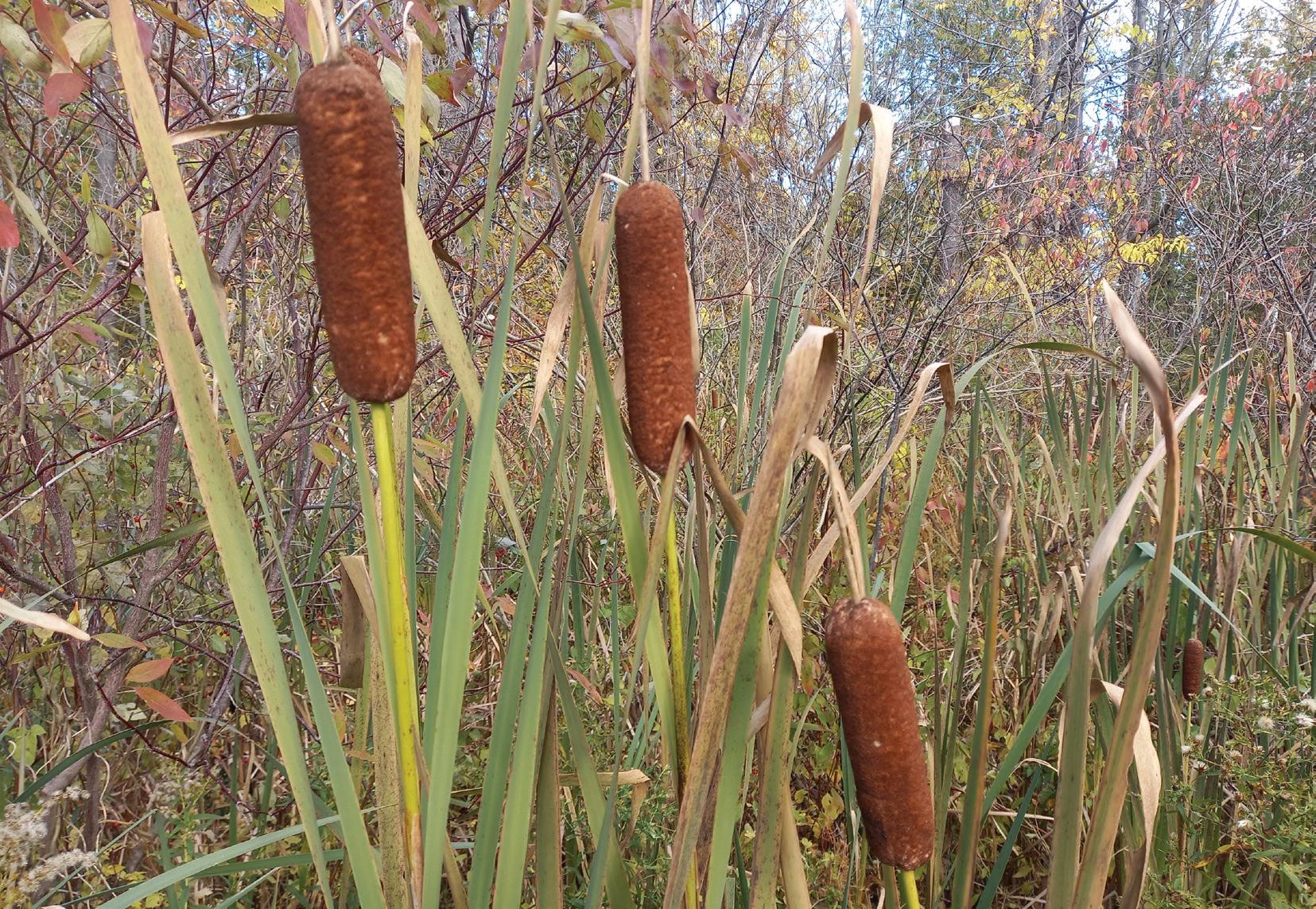
Broad-leaved Cat-tail (Typha latifolia)
Featured Wetland Type: Emergent Marsh
Other Wetland Types: Bog, Fen, Northern Wet Meadow
Best Season: Summer
C Value: 1
The well-known and distinctive flowering heads on cattails set them apart from all other wetland plants. Female plants have corn-dog-like flowers that grow in various sizes. The leaves can grow up to seven feet tall or higher depending on the soil conditions.
Fun Fact:
Wildlife such as muskrats love this species, which contains more starch than potato and more proteins than rice.
43
PHOTO: ANGIE BOUMA
GTRLC.ORG

Buttonbush (Cephalanthus occidentalis)
Featured Wetland Type: Northern Shrub Thicket
Other Wetland Types: Bog
Best Season: Summer
C Value: 7
When standing water conditions become too deep for tag alder, the northern shrub thicket sometimes switches over to a inundated shrub swamp. This species has distinctive white, globe-shaped flowers and is found in many habitats. It can also grow quite tall, over 15 feet high!
Fun Fact:
This unique and beautiful plant is in the same family as coffee, the Rubiaceae or “madder” family. Its shiny leaves grow opposite each other in whorls of three, like coffee shrubs.
Upper Manistee Headwaters: The Milock Family Preserve | Plants 44
PHOTO: RICK KANE

Canadian Fly Honeysuckle (Lonicera canadensis)
Featured Wetland Type: Hardwood Conifer Swamp
Other Wetland Types: Rich Conifer Swamp
Best Season: Summer
C Value: 5
Out of the fifteen Lonicera species that grow in Michigan, more than half are non-native, invasive shrubs that often escape from cultivation. However, there are around six native species. This native honeysuckle is the most commonly observed, as it is rather hardy and can grow in many types of habitats. It often grows on drier hummous in cedar swamps. In the early spring, its yellow, bell-shaped flowers bloom in pairs underneath opposite leaves.
Fun Fact:
Hummingbirds love to feed on the nectar of this plant’s tubular flowers.
45
PHOTO: ANGIE BOUMA
GTRLC.ORG
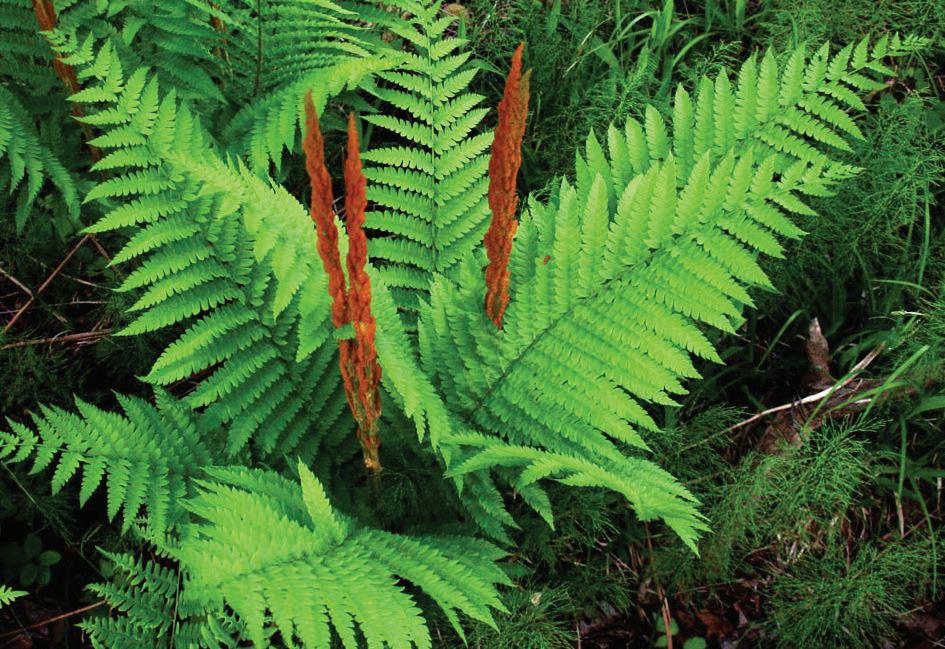
Cinnamon Fern (Osmundastrum cinnamomeum)
Featured Wetland Type: Rich Conifer Swamp
Other Wetland Types: Hardwood Conifer Swamp, Northern Shrub Thicket
Best Season: Summer-Fall
C Value: 5
Found in almost every county in Michigan, this fern is easily identified by its cinnamon-colored fertile frond, a modified leaf that houses the sporangia or spores. Cinnamon fern is related to royal fern (Osmung regalis), which tends to grow in wetter conditions.
Fun Fact:
This family of ferns dates back to fossil record of approximately 160 million years ago and has remained relatively unchanged, even at a cellular level.
Upper Manistee Headwaters: The Milock Family Preserve | Plants 46
PHOTO: ANGIE BOUMA

Goldthread (Coptis trifolia)
Featured Wetland Type: Rich Conifer Swamp
Other Wetland Types: Hardwood Conifer Swamp, Muskeg, Poor Conifer Swamp
Best Season: Year-round
C Value: 5
This is a unique little perennial that grows no higher than 12cm tall and is often found growing under cedar and hemlock trees in mossy microtopography. It has yellow to orange rhizomes, basal leaves divided into three egg-shaped leaflets, and solitary flowers that are fleshy and a whitish color.
Fun Fact:
This is a plant of cool, shady habitats that blooms early and quickly in the spring.
47
PHOTO: CHRIS GARROCK
GTRLC.ORG

Grass Pink (Calopogon tuberosus)
Featured Wetland Type: Bog
Other Wetland Types: Poor Fen
Best Season: Summer
C Value: 9
Michigan is home to more than 50 species of native orchids, some of which are striking while others can be difficult to spot due to their diminutive or cryptic flowers. However, the grass pink orchid puts on quite a show. This bumble bee-pollinated orchid is the most common of the “bog-pinks” which include Arethusa, Calopogon and Pogonia.
Fun Fact:
This orchid’s pollination process is fascinating. As bumblebees land on the upper lip of the flower, they are thrown backward, and their backs are dipped in pollen. There is no nectar reward, and the bumblebees fly off to another flower to repeat the process. This method works best with newly emerged and naïve bumblebees.
Upper Manistee Headwaters: The Milock Family Preserve | Plants 48
PHOTO: ANGIE BOUMA
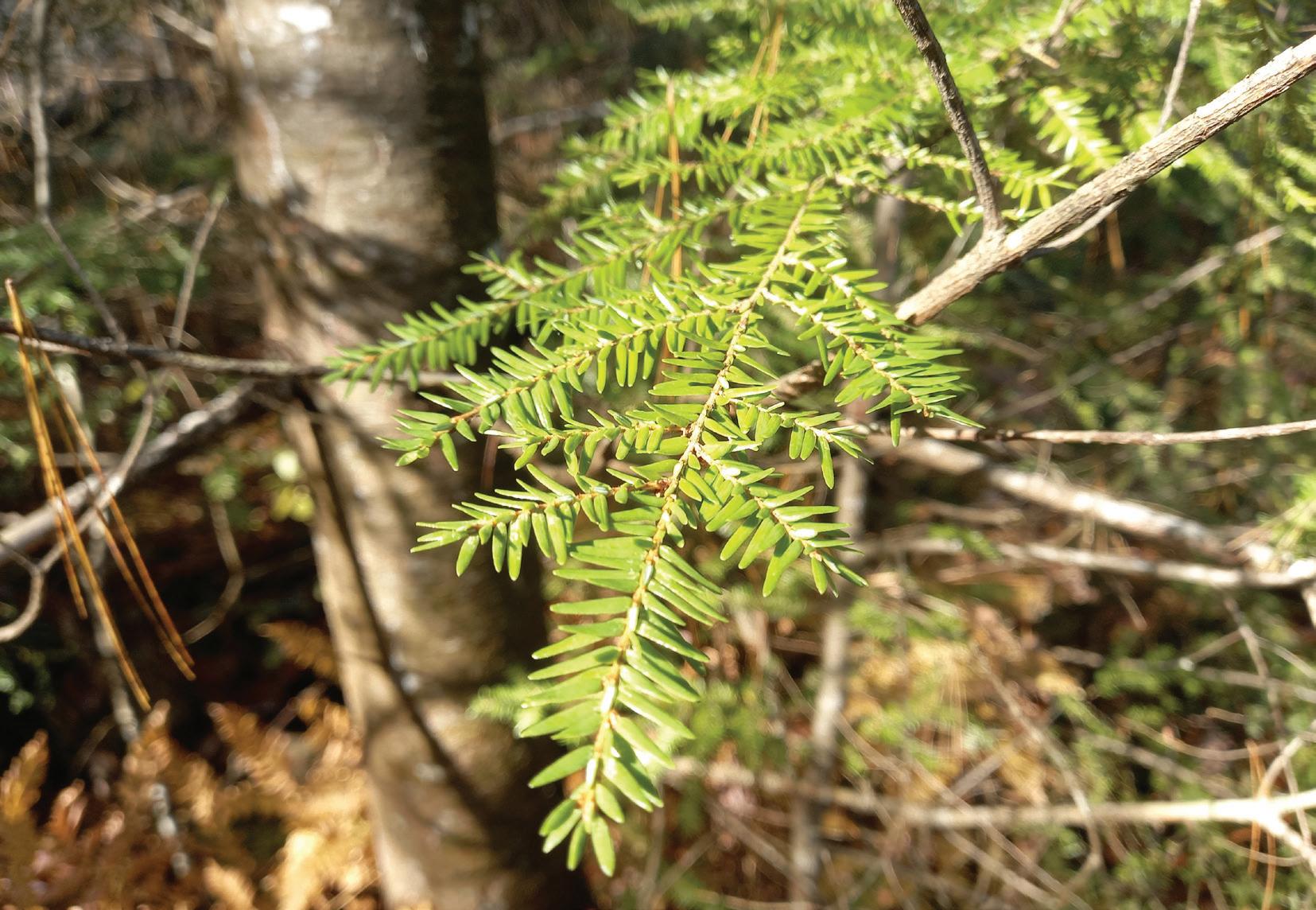
Hemlock (Tsuga canadensis)
Featured Wetland Type: Hardwood Conifer Swamp
Other Wetland Types: Rich Conifer Swamp
Best Season: Year-round
C Value: 5
Hemlock is a shade-tolerant tree that germinates in the soft needles of its groves. Its needles can be mistaken for cedar or balsam fir, but are shorter and have various other characteristics that differentiate them. Hemlock stands are unique, being shallow-rooted and interconnected, the trees grow best when they grow together. If a stand is weakened or thinned out too much, the remaining trees are more susceptible to wind events.
Fun Fact:
Like cedar, hemlock is an extremely long-lived tree species, and there are remnant old-growth stands in northern lower Michigan. You may discover small pockets of hemlocks along trails at GTRLC’s preserves that are over 250 years old. Due to their slow growth, they can look the same age as a 100-year-old white pine, a much faster-growing species.
49
PHOTO: ANGIE BOUMA
GTRLC.ORG
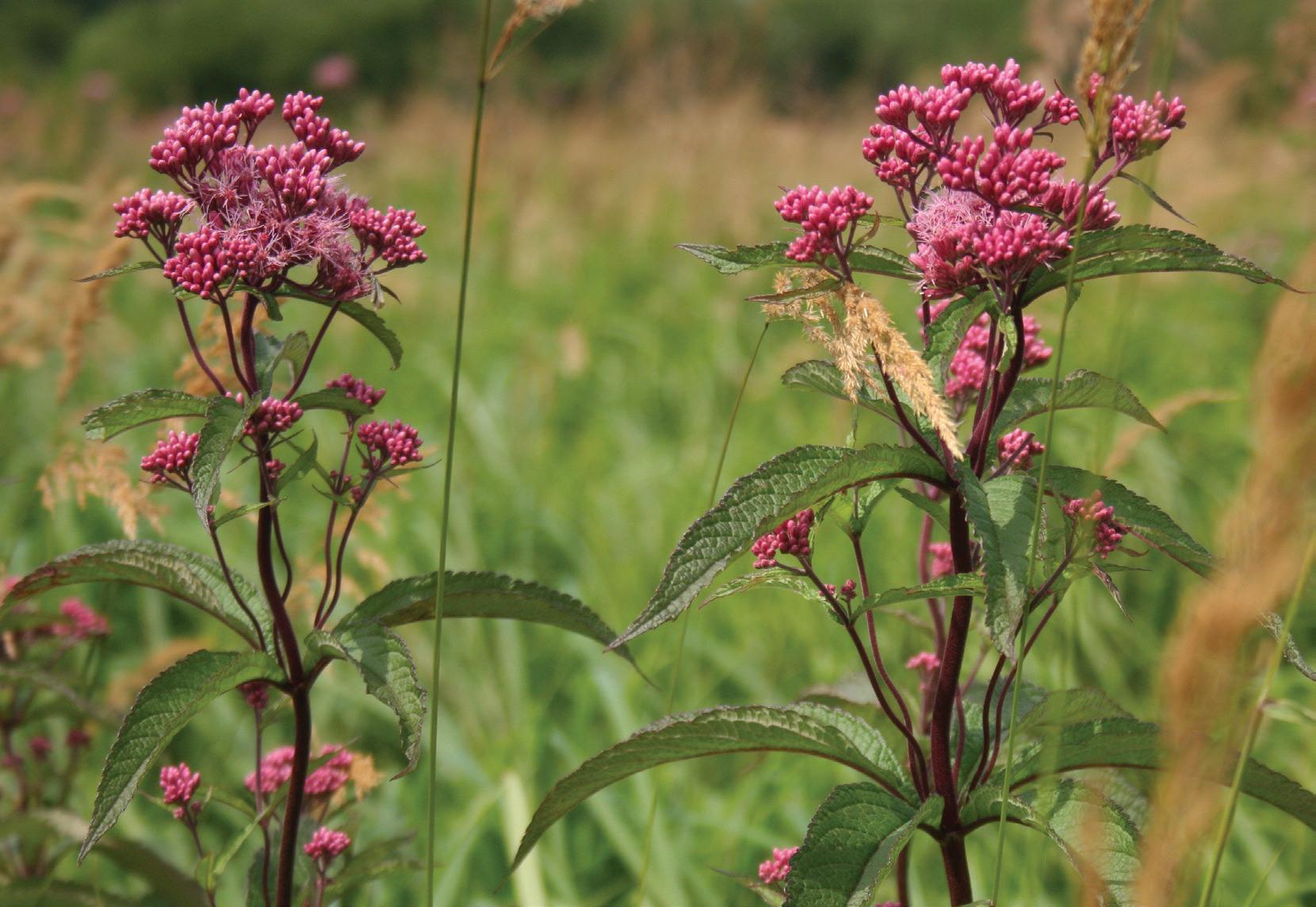
Joe-pye Weed (Eutrochium maculatum)
Featured Wetland Type: Northern Wet Meadow
Other Wetland Types: Northern Shrub Thicket
Best Season: Summer-Fall
C Value: 4
This member of the Aster family blooms in the summer and fall. Look for pink-purple flowers and leaves in whorls of three to seven. It can grow up to 10 feet tall!
Fun Fact:
This is an excellent nectar source for pollinators—its blooms provide abundant nectar to traveling and resident insect species, including Monarchs and many other declining insect species.
Upper Manistee Headwaters: The Milock Family Preserve | Plants 50
PHOTO: ANGIE BOUMA

Labrador Tea (Rhododendron groenlandicum)
Featured Wetland Type: Poor Conifer Swamp
Other Wetland Types: Bog, Muskeg, Poor Fen, Rich Conifer Swamp
Best Season: Early Summer
C Value: 8
This small evergreen shrub grows in sphagnum-rich or acidic habitats, typically near short and scrubby black spruce and tamarack trees. It produces clusters of small, white flowers in June, and has distinctive white hairs on the undersides of its leaves. The leaves are white when the plant is young, and turn rusty brown in its second year.
Fun Fact:
This plant is likely named after the first place botanists discovered it, and it’s a characteristic plant of the vast muskegs and bogs of the northern latitudes.
51
PHOTO: RICK KANE
GTRLC.ORG
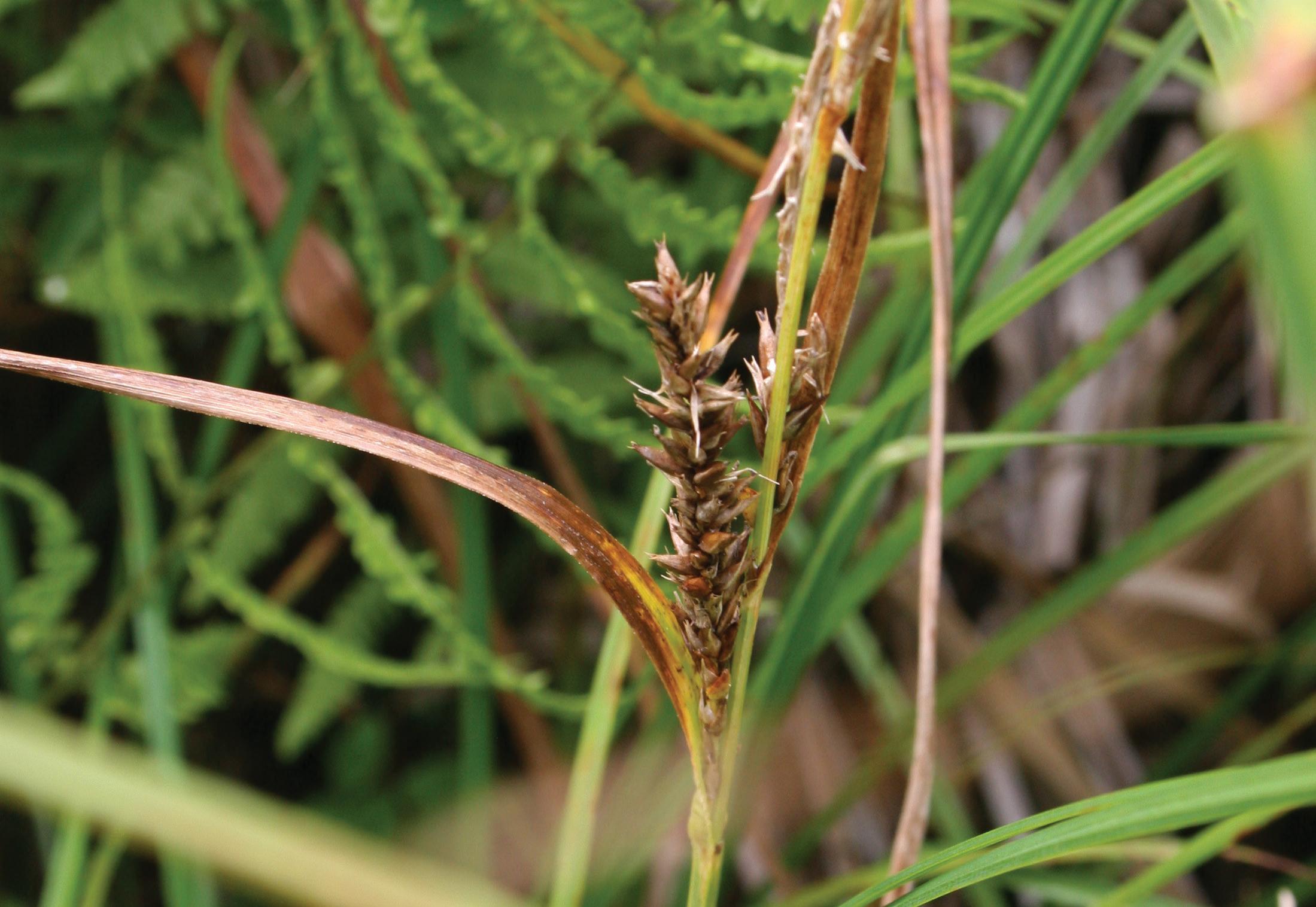
Lake Sedge (Carex lacustris)
Featured Wetland Type: Northern Wet Meadow
Other Wetland Types: Northern Shrub Thicket
Best Season: Spring-Fall
C Value: 6
This plant forms extensive colonies along rivers and stream banks and is found in numerous wetland habitat types. This is one of the largest sedges, and its unusually long leaves, which have a deep “W” shaped channel and peel all the way toward the base, help to distinguish it from other wetland sedges. It grows in shallow, standing water in a variety of habitats.
Fun Fact:
Many waterfowl, rails and songbirds eat the seeds or spikelets of this species and other sedges.
Upper Manistee Headwaters: The Milock Family Preserve | Plants 52
PHOTO: COLON CHAPMAN

Leatherleaf (Chamaedaphne calyculata)
Featured Wetland Type: Bog
Other Wetland Types: Muskeg, Poor Conifer Swamp, Poor Fen
Best Season: Spring
C Value: 8
After sphagnum mosses create a carpet on decaying vegetation and form mats, the leatherleaf shrub is the next keystone species to grow in a bog and can become the dominant species. Leatherleaf is known for its ability to grow and form mats in very wet and nutrient-poor habitats, which serve as the substrate for other bog plants. It generally doesn’t grow higher than three feet tall, and in winter, its leaves turn bronze in color.
Fun Fact:
In bogs, this plant can be the dominant species. It is a member of hardy shrubs called “heath shrubs” that are commonly found in bogs. These shrubs belong to the Ericaceae family and include other popular species like blueberries, cranberries, bog rosemary, bog laurel and many other attractive shrubs that feature small, bell-shaped and tubular flowers.
53
PHOTO: ASHLEY SUMNER
GTRLC.ORG
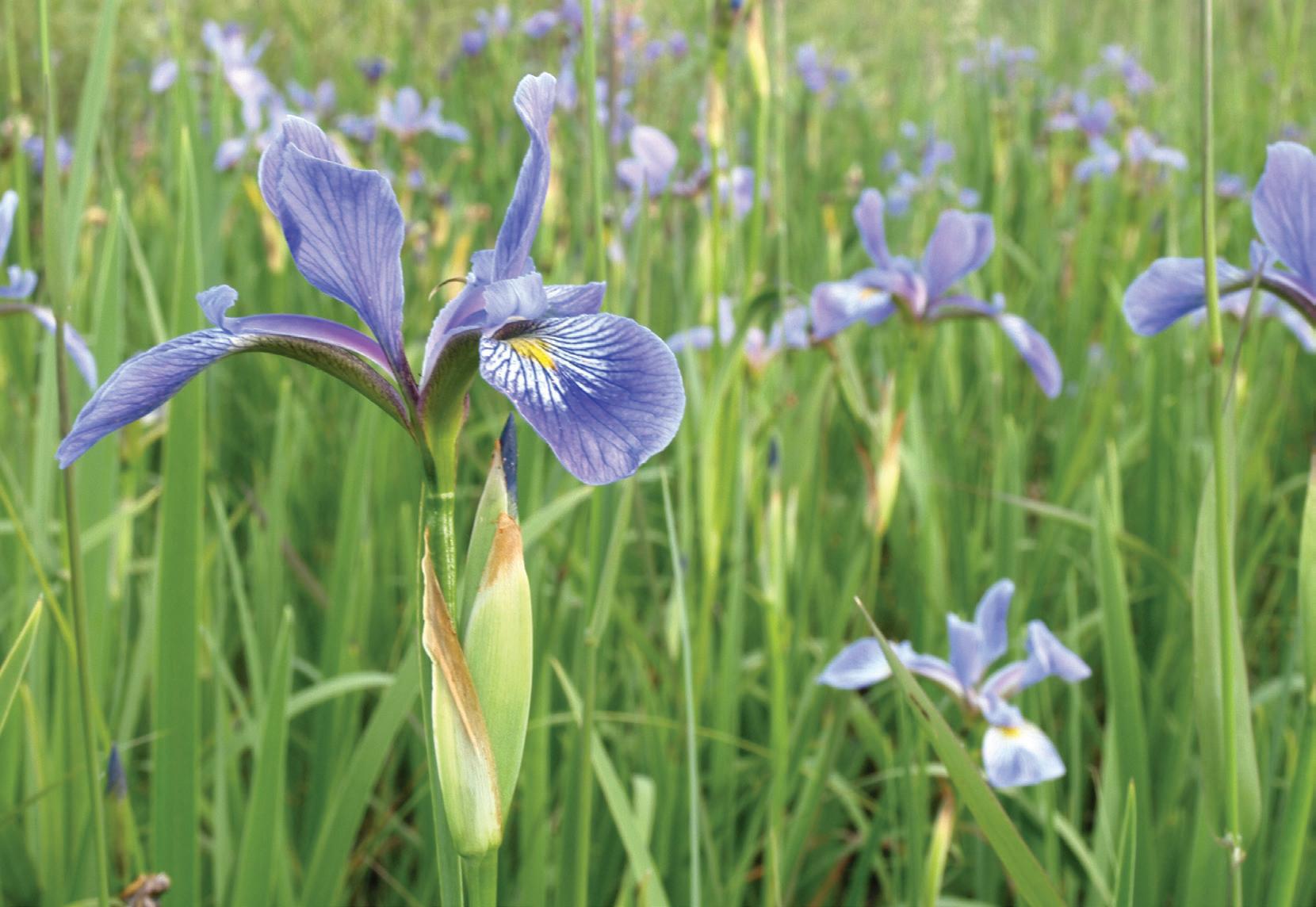
Northern Blue Flag Iris (Iris versicolor)
Featured Wetland Type: Poor Fen
Other Wetland Types: Poor Conifer Swamp, Northern Shrub
Thicket, Northern Wet Meadow, Rich Conifer Swamp
Best Season: Early Summer
C Value: 5
This beloved, open meadow bloomer is native to many wetland types and is closely related to the lily family. This species is primarily found in northern regions of Michigan. More common in southern Michigan is southern blue flag iris, Iris virginica, which has a distinctive yellow dot on the sepals of the flower.
Fun Fact:
Though a beautiful and well-known wildflower, this plant has toxic chemicals in its roots and leaves, which can be poisonous if mistaken for an edible cattail. The flower is important for many species of pollinator insects and is popular with hummingbirds.
Upper Manistee Headwaters: The Milock Family Preserve | Plants 54
PHOTO: NATE RICHARDSON
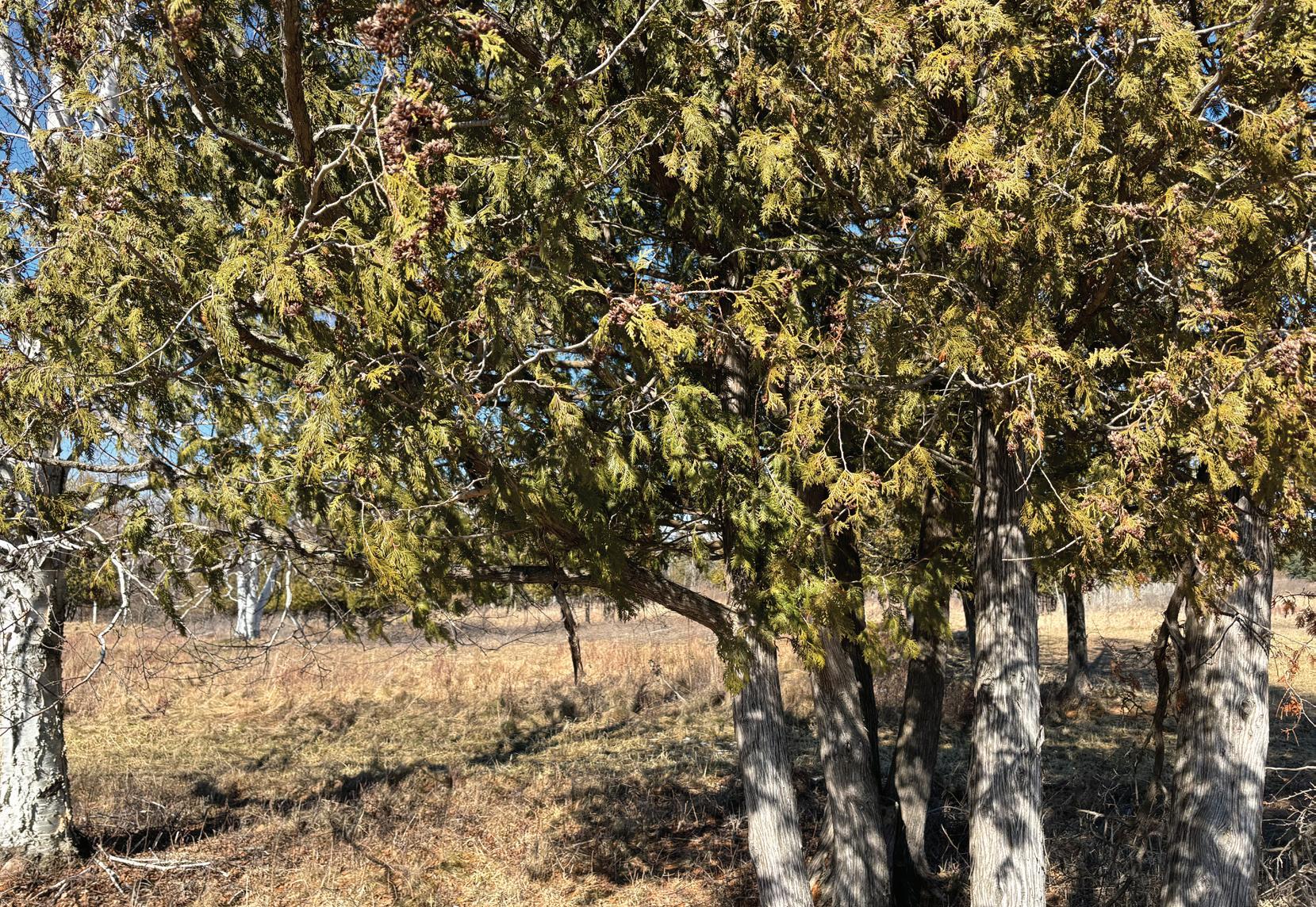

Northern White Cedar (Thuja occidentalis)
Featured Wetland Type: Rich Conifer Swamp
Other Wetland Types: Hardwood Conifer Swamp, Northern Shrub Thicket
Best Season: Year-round
C Value: 4
This unique tree is frequently cultivated and has over 300 landscaping cultivars. Its native habitat ranges across the north country, from southern Michigan and the northeastern United States to the Arctic tree line. It is a very slow-growing species, whose shorter stature and smaller trunk diameter can disguise its true age.
Fun Fact:
The Nookomis Giizhik, or “Grandmother Cedar” in Ojibwe culture, is also known as the “tree of life” in horticultural use. Seeds are produced at around 30 years old, with the optimal age for seed production being 75. If conditions are favorable, this tree’s lifespan is around 400 years, with the oldest known living specimen being 1,141 years old as of 2008.
55
PHOTO: NATE RICHARDSON
GTRLC.ORG

Pitcher Plant (Sarracenia purpurea)
Featured Wetland Type: Bog
Other Wetland Types: Muskeg, Poor Conifer Swamp, Poor Fen
Best Season: Spring-Fall
C Value: 10
Although pitcher plants are a diverse group, this is the only member of the family in Michigan. This fascinating species has deep maroon-colored petals on blooms that stick out above its modified leaf structures. The leaves form “pitchers” that trap insects, providing additional nutrients and minerals that are often lacking in the nutrient-poor habitats where it thrives.
Fun Fact:
Considered among the most ravenous plants, this unique species is capable of trapping thousands of insects. Sarracenia purpurea lacks a hood, which allows rainwater to enter its “pitcher” and insects are killed by drowning in water. As the water dries out the insects are digested by the leaves of the plant.
Upper Manistee Headwaters: The Milock Family Preserve | Plants 56
PHOTO: NATE RICHARDSON
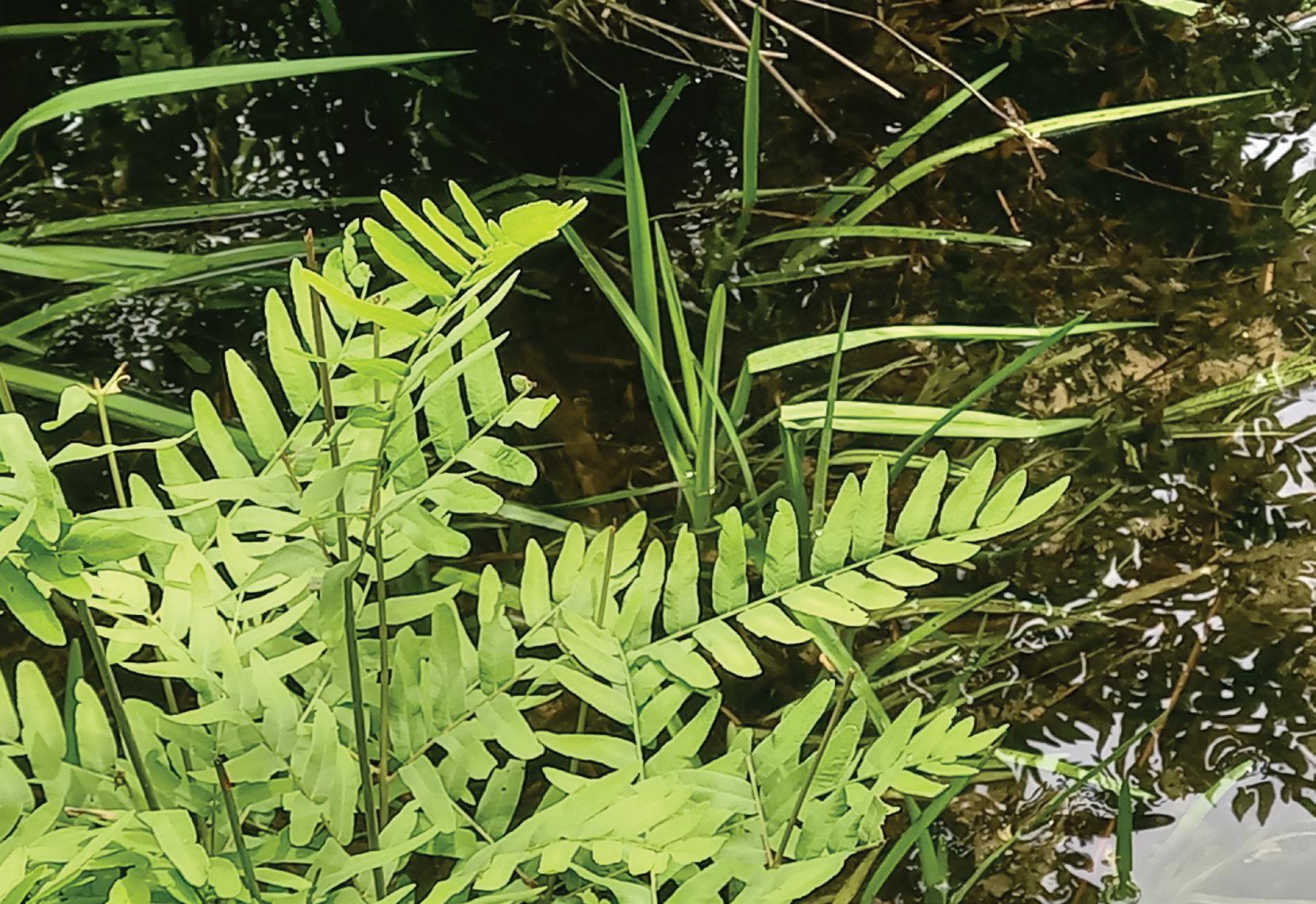
Royal Fern (Osmunda regalis)
Featured Wetland Type: Northern Shrub Thicket
Other Wetland Types: Hardwood Conifer Swamp, Poor Conifer Swamp
Best Season: Summer
C Value: 5
One of the largest ferns in eastern North America, this fern can grow up to six feet tall and thrives in very wet conditions. The pinnules, which are the smallest segments of the plant’s leaves, are distinctive because they are divided. The fertile frond is a branched, flower-shaped arrangement of golden-colored sporangia (vessels in which asexual spores are formed).
Fun Fact:
The plant’s common name comes from its branched, golden sporangia, which resemble a crown.
57
PHOTO: ANGIE BOUMA
GTRLC.ORG
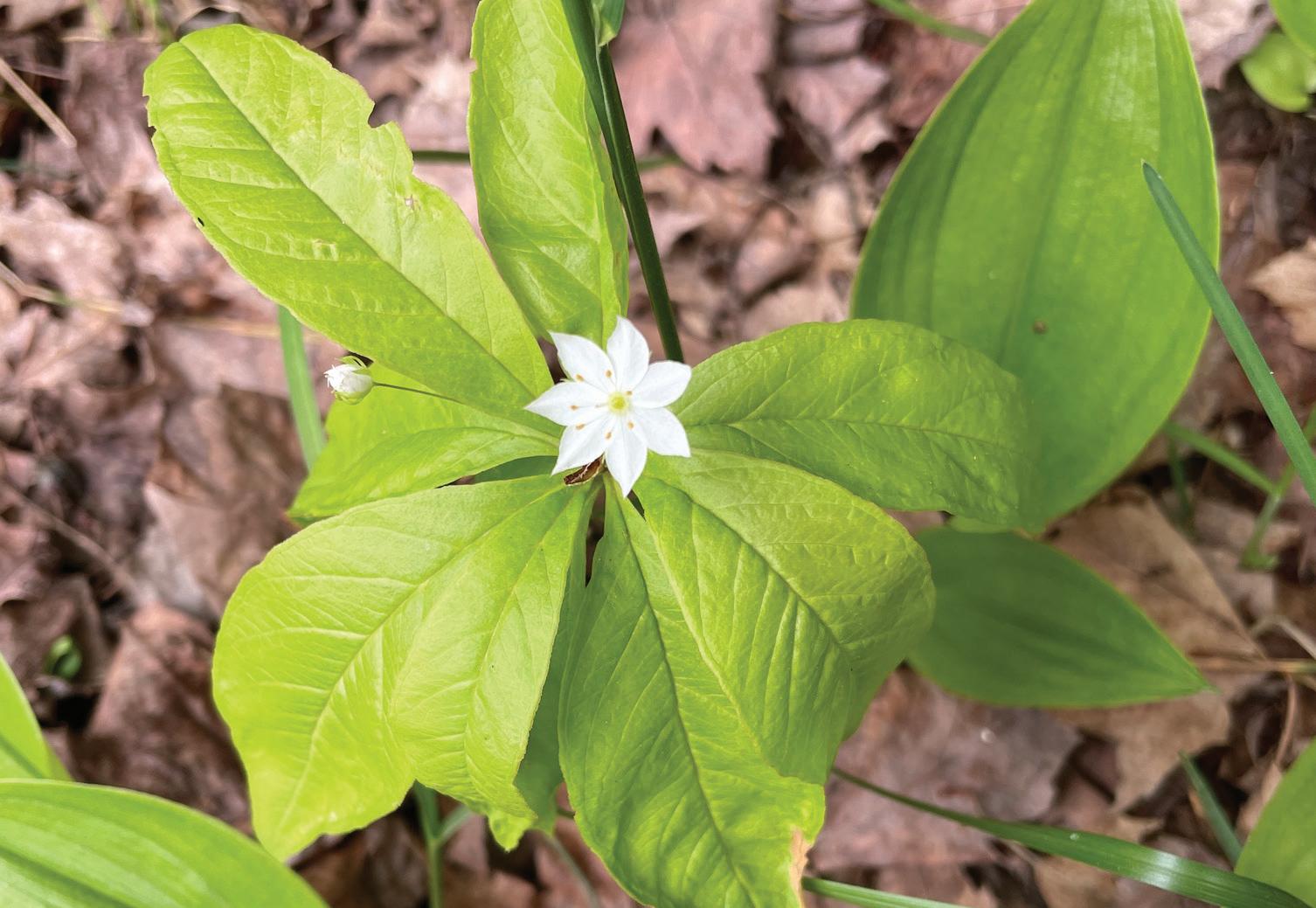
Starflower (Trientalis borealis)
Featured Wetland Type: Rich Conifer Swamp
Other Wetland Types: Hardwood Conifer Swamp, Poor Conifer Swamp
Best Season: Spring
C Value: 5
This perennial herb is a member of the primrose family. It has seven petals that open in late spring and leaves that occur in irregular whorls at the tip of the stem. It prefers open to dappled shade in moist woods but can also be found in dry, sandy and acidic soils.
Fun Fact:
The genus name Trientalis is from the Latin meaning “one-third of a foot,” referencing the plant’s height. The species name borealis translates to “being from the north,” although this plant is also found at higher elevations in the southern Appalachian Mountains.
Upper Manistee Headwaters: The Milock Family Preserve | Plants 58
PHOTO: CINDY BLOOM, VIA INATURALIST

Swamp Loosestrife (Decodon verticillatus)
Featured Wetland Type: Emergent Marsh
Best Season: Summer
C Value: 7
This shrubby but mostly herbaceous plant is easily mistaken for its close relative, the invasive purple loosestrife (Lythrum salicaria). However, the native species has a distinctive growth habit, in which its stems or canes arch over the edge of the shoreline along lakes and streams.
Fun Fact:
These plants can colonize open edge aquatic habitats quickly and when in bloom, they create beautiful clusters of flowering plants that arch gracefully along our freshwater shorelines.
59
PHOTO: ANGIE BOUMA
GTRLC.ORG

Swamp Milkweed (Asclepias
incarnata)
Featured Wetland Type: Northern Wet Meadow
Other Wetland Types: Northern Shrub Thicket
Best Season: Summer C Value: 6
Out of the 12 native milkweed species found in Michigan, this is the only species that grows in water. It can grow in rows up to four feet high with narrow, opposite leaves. Its very fragrant and structurally unique flowers are pink to red in color.
Fun Fact:
Like other milkweeds, this plant is of critical importance to monarch butterflies, which lay their eggs on this plant. The caterpillars feed on the plant as they grow, accumulating mildly toxic chemicals that make them unpalatable to predators.
Upper Manistee Headwaters: The Milock Family Preserve | Plants 60
PHOTO: ANGIE BOUMA

Sweet-scented Water Lily (Nymphaea odorata)
Featured Wetland Type: Submergent Marsh
Other Wetland Types: Emergent Marsh
Best Season: Summer
C Value: 6
This long-lived perennial sets root in water ranging from 1.5 to 6.5 feet in depth. After fertilization, the flower stalk curls like a corkscrew, drawing the flower underwater. The seeds are then released under the leaf mat and dispersed. This plant produces a single, large and fragrant white flower on each stem, which can measure up to six inches in diameter. The flower has over 25 petals and around 70 stamens. It is pollinated by both insects and wind and despite blooming for only a few days, the plant staggers its blossoms to use pollinators efficiently and elongate its flowering season.
Fun Fact:
Populations of this plant can fluctuate due to changes in water levels, beaver dam activity or substrate changes, but under ideal conditions, the plant has been known to grow for 15-20 years or longer.
61
PHOTO: ANGIE BOUMA
GTRLC.ORG
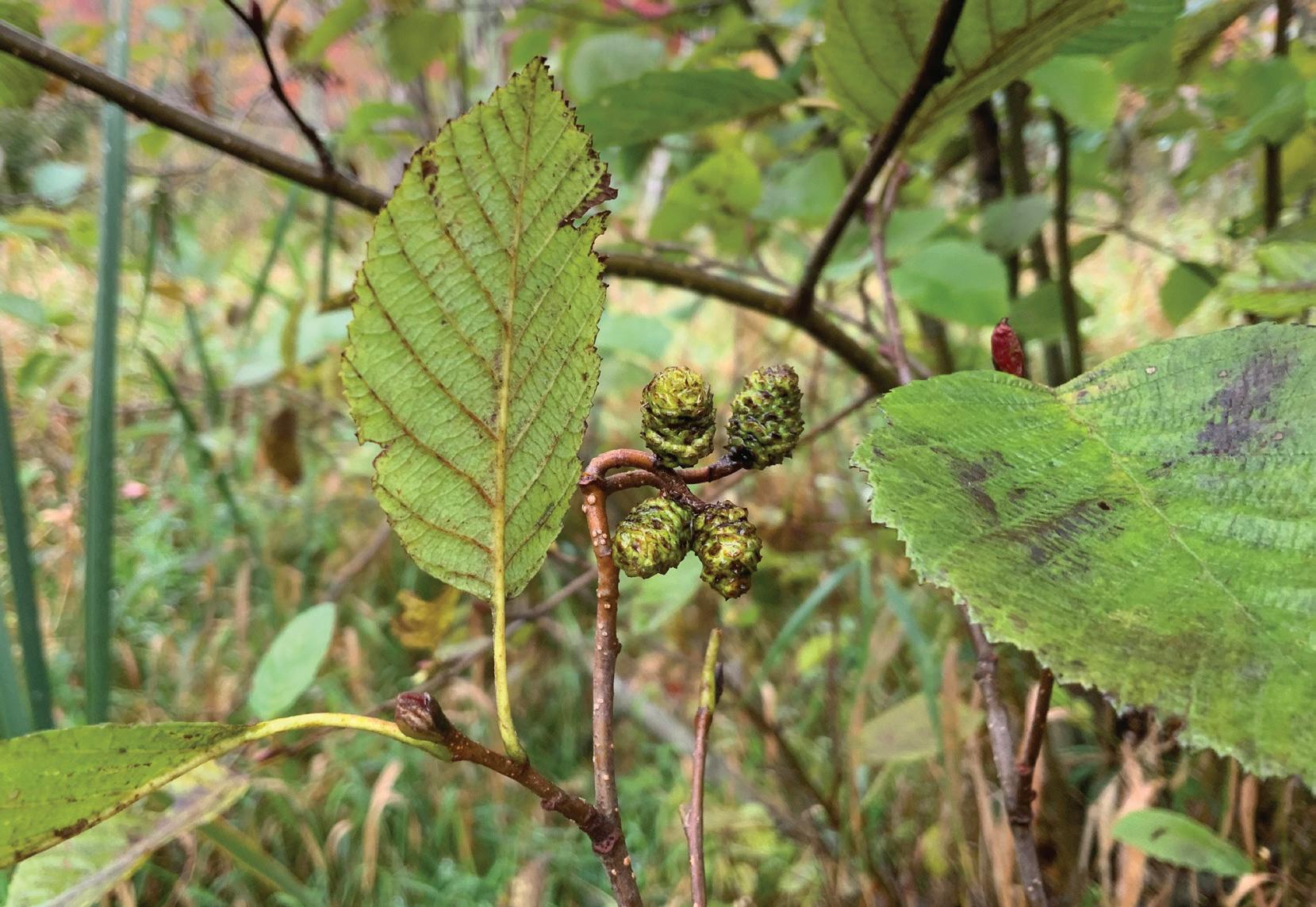
Tag Alder (Alnus incana ssp. rugosa)
Featured Wetland Type: Northern Shrub Thicket
Other Wetland Types: Hardwood Conifer Swamp, Northern Wet Meadow, Rich Conifer Swamp
Best Season: Spring-Fall
C Value: 5
This tall deciduous, native shrub stands 10-20 feet high and has alternating leaves that are doubly serrated or “toothed” along the margins. With sprawling branches and multiple trunks, this shrub creates thickets that provide valuable habitat for many plants and animals but can make traversing wetlands challenging.
Fun Fact:
Tag alder is monecious, meaning it produces male and female catkins, or flowers, on the same plant. Female flowers develop into cone-like fruits.
Upper Manistee Headwaters: The Milock Family Preserve | Plants 62
PHOTO: ANGIE BOUMA
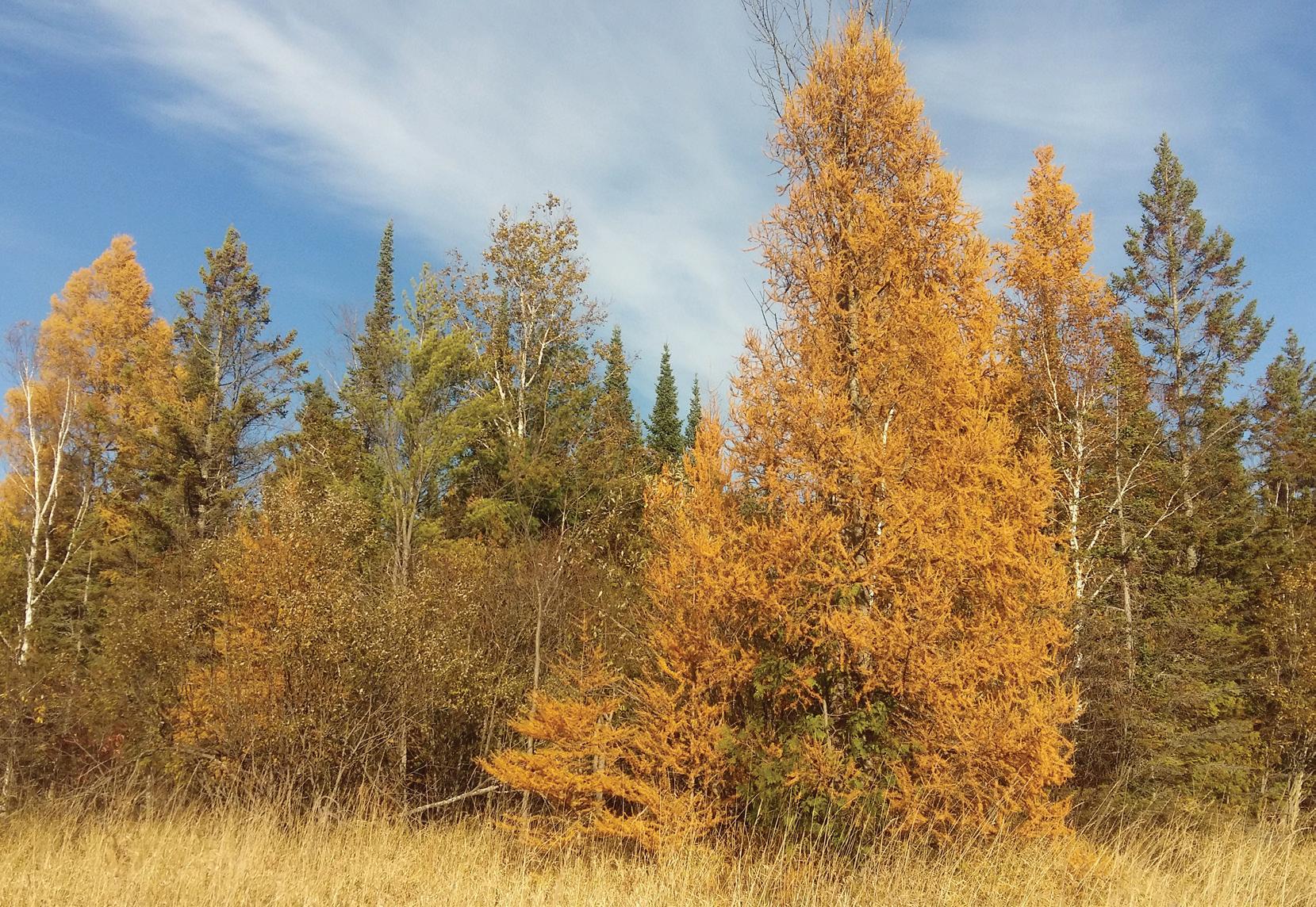
Tamarack (Larix laricina)
Featured Wetland Type: Poor Conifer Swamp
Other Wetland Types: Bog, Hardwood Conifer Swamp, Muskeg, Northern Shrub Thicket, Poor Fen, Rich Conifer Swamp
Best Season: Fall
C Value: 5
This species is striking in the fall when its soft needles turn a golden color. It does not tolerate shade, and as a result, it is eventually succeeded by other species, such as black spruce, northern white cedar, balsam fir or hardwood species.
Fun Fact:
This tree is known as the only deciduous conifer (cone-bearing) tree in Michigan, however, all conifers lose their needles annually. Most conifers shed them over the year, as old needles are replaced by new ones, whereas tamaracks shed all their needles in the fall.
63
PHOTO: ANGIE BOUMA
GTRLC.ORG

Tawny Cotton-grass (Eriophorum virginicum)
Featured Wetland Type: Muskeg
Other Wetland Types: Bog, Poor Fen
Best Season: Fall-late Fall
C Value: 8
This distinctive species belongs to the sedge family and is characterized by its tufted, grass-like appearance. The plant typically reaches heights of 1-3 feet and is easily identified by its unique seed heads, which resemble tufts of cotton. During the growing season, it produces slender stems with elongated leaves, and blooms with small, inconspicuous flowers.
Fun Fact:
This plant’s fluffy, tawny-colored seed heads are often bring to mind the texture of cotton, but they are actually composed of numerous silky hairs that aid in wind dispersal of the seeds.
Upper Manistee Headwaters: The Milock Family Preserve | Plants 64
PHOTO: NATE MARTINEAU VIA INATURALIST

Three-sided Sedge (Dulichium arundinaceum)
Featured Wetland Type: Emergent Marsh
Other Wetland Types: Bog, Muskeg, Northern Wet Meadow, Poor Fen, Poor Confier Swamp
Best Season: Summer
C Value: 8
Also called three-way sedge, this distinctive sedge has three ranked leaves that are angled alternatively up the stem. When viewed from above, the leaves are arranged into three columns.
Fun Fact:
This native sedge is mainly found in the Great Lakes region, the northeastern United States and adjacent areas in Canada.
65
PHOTO: ANGIE BOUMA
GTRLC.ORG
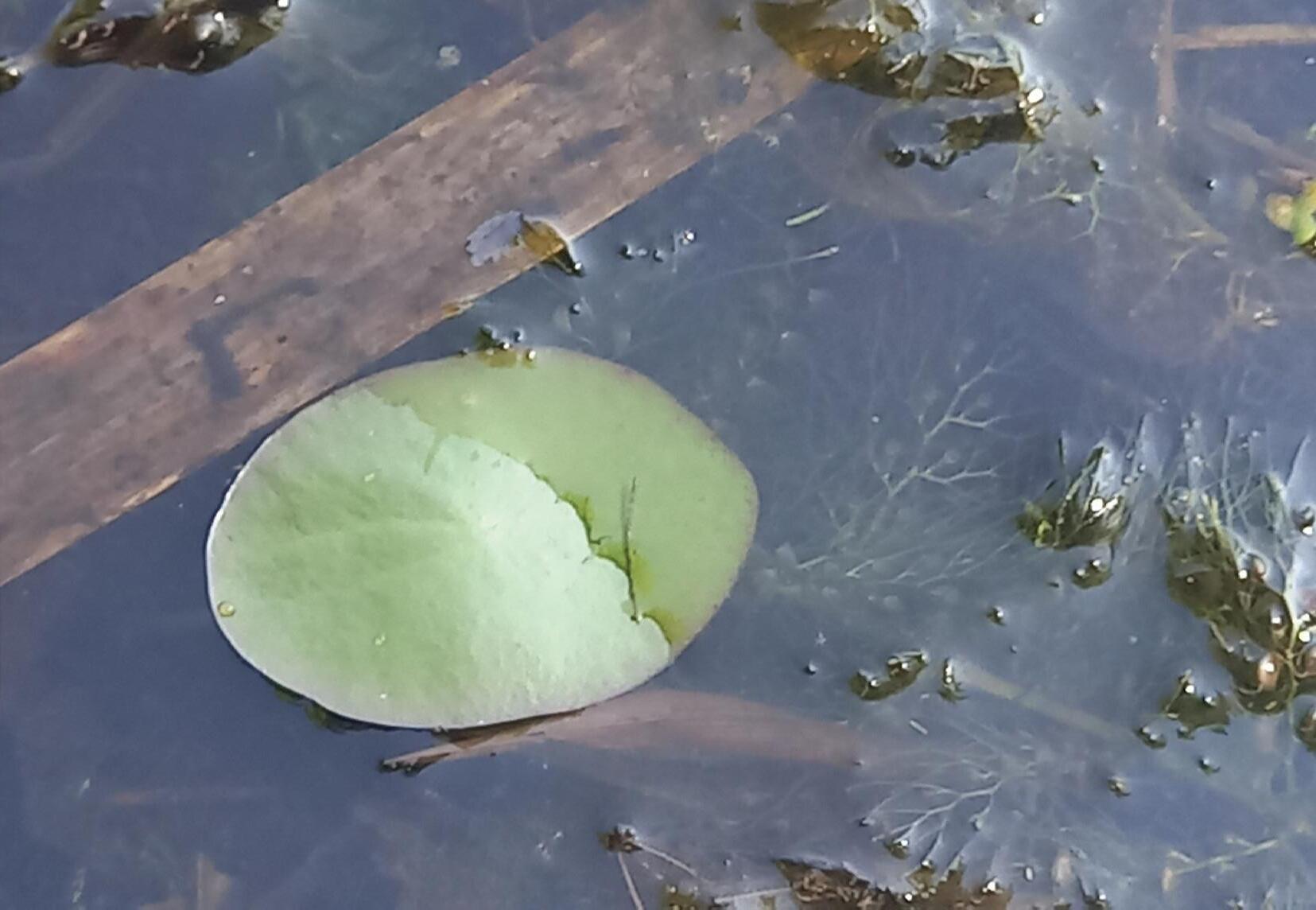
Watershield (Brasenia schreberi)
Featured Wetland Type: Submergent Marsh
Other Wetland Types: Emergent Marsh
Best Season: Summer C Value: 6
Watershield grows in areas of lakes with low wave action, or in deep water ponds surrounded by bog mats. This rooted and floating aquatic plant is unique as the stem is in the middle of its slime-covered leaf.
Fun Fact:
This hardy aquatic plant is widespread throughout the world and provides excellent wildlife benefits. Its flower buds emerge underwater and fruit develops underwater, which helps with seed dispersal.
Upper Manistee Headwaters: The Milock Family Preserve | Plants 66
PHOTO: ANGIE BOUMA

White Beak-rush (Rhynchospora alba)
Featured Wetland Type: Poor Fen
Other Wetland Types: Bog, Muskeg
Best Season: Summer
C Value: 6
Despite its name, this species is in the Carex (sedge) family and thrives in open, acidic soils, often growing in colonies. It produces small, delicate flowers with pale-colored petals that are typically arranged in compact clusters or spikelets at the tips of its slender, grass-like stems. The plant has thin, triangular leaves that are typically dark green and linear in shape.
Fun Fact:
There are eight beak-rushes in Michigan and half of those are listed as threatened by the State of Michigan.
67
PHOTO: ANGIE BOUMA
GTRLC.ORG

White Pine (Pinus strobus)
Featured Wetland Type: Poor Conifer Swamp
Other Wetland Types: Bog, Hardwood Conifer Swamp, Muskeg, Northern Shrub Thicket, Poor Fen, Rich Conifer Swamp
Best Season: Year-round
C Value: 3
The largest coniferous tree native to eastern North America, often growing to heights of 80-100 feet. This towering tree’s branches are tiered horizontally, with tufts of blue-green needles in clusters of five near the end of its twigs.
Fun Fact:
White pine is an important nesting tree for bald eagles as it rises above the tree line, and can support the heavy weight of their nests.
Upper Manistee Headwaters: The Milock Family Preserve | Plants 68
PHOTO: TALULA FOOTE

Winterberry (Ilex verticillata)
Featured Wetland Type: Northern Shrub Thicket
Other Wetland Types: Bog, Hardwood Conifer Swamp, Poor Conifer Swamp, Rich Conifer Swamp
Best Season: Fall-Winter
C Value: 5
This tall shrub has thick and shiny alternate leaves with toothed edges. It grows with tag alder, willows and other wetland shrubs, and in the fall and winter, it produces bright red berries that are easily seen.
Fun Fact:
This plant’s bright red berries last for quite a while and provide food for wildlife well into the winter season.
69
PHOTO: ANGIE BOUMA
GTRLC.ORG
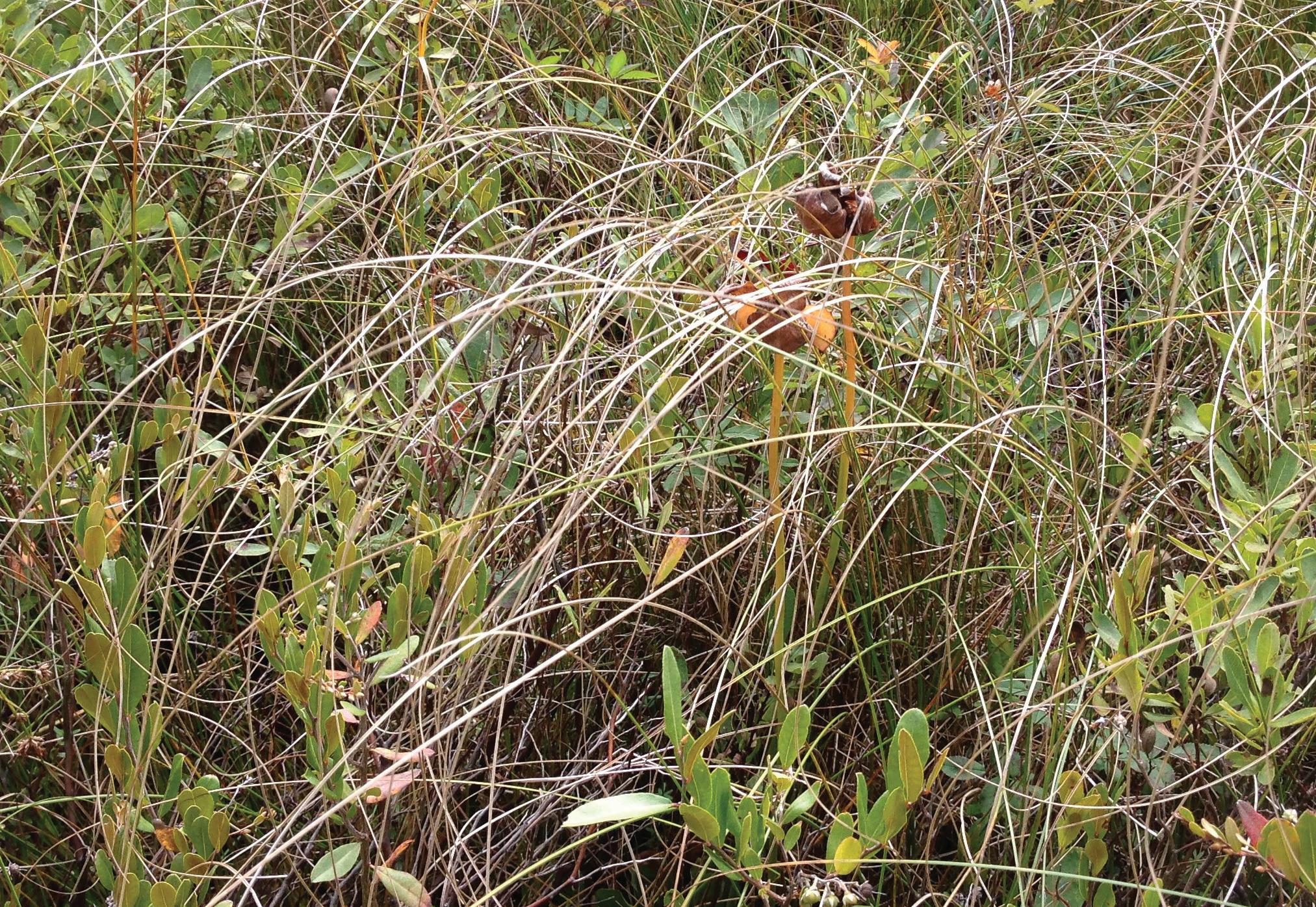
Wiregrass Sedge (Carex lasiocarpa)
Featured Wetland Type: Poor Fen
Other Wetland Types: Bog, Muskeg
Best Season: Summer-Fall
C Value: 8
Also known as woolly-fruited sedge, this plant prefers wetter sites and can even grow in shallow water. It has a ladder-like cross-section and a rhizome system that can create floating mats, which are common in sphagnum areas.
Fun Fact:
This plant’s common name derives from the rigid construction of its leaves and stems, which are round in cross-section and “tough as wire.” This unique feature gives the plant strength and allows it to withstand wind and rain.
Upper Manistee Headwaters: The Milock Family Preserve | Plants 70
PHOTO: ANGIE BOUMA

Yellow Birch (Betula alleghaniensis)
Featured Wetland Type: Hardwood Conifer Swamp
Other Wetland Types: Rich Conifer Swamp
Best Season: Year-round
C Value: 7
Named for the golden hue of its outer bark that peels more as it ages, yellow birch is another slow-growing, shade-tolerant tree species that can live over 300 years. However, this tree is susceptible to heat and drought, and it is extremely sensitive to minor habitat changes. It is not common to see a young birch south of the northern lower Michigan floristic tension line, which runs from Muskegon to Saginaw Bay, separating the lower peninsula into north and south ecosystems.
Fun Fact:
This long-lived member of the birch family is the largest birch in the northeastern United States. As a preferred food source for deer, it is over-browsed and now rather rare.
71
PHOTO: LIANA MAY, VIA INATURALIST
GTRLC.ORG

Yellow Pond Lily (Nuphar variegata)
Featured Wetland Type: Submergent Marsh
Other Wetland Types: Emergent Marsh
Best Season: Summer
C Value: 7
Another classic “lilypad” found throughout northern Michigan and elsewhere in the northern states, the yellow (or variegated) pond lily is an unmistakable aquatic plant, featuring yellow flowers and heart-shaped floating leaves.
Fun Fact:
This plant benefits a very wide range of wildlife, providing food and shelter for fish, snails, crayfish, birds, turtles, underwater insects and amphibians. Some invertebrate species appear to spend their entire life cycle on this plant.
Upper Manistee Headwaters: The Milock Family Preserve | Plants 72
PHOTO: KATHY PARTIN
GLOSSARY
Common name – The vernacular name for a species, as distinguished from its scientific name. There are often multiple common names for a single species.
Ecosystem – A dynamic biological community balanced between plants, animals and the surrounding environment.
Ecotone – A transitional area between two biological communities, sometimes forming a new and different community.
Embayment – Lakes or ponds that once opened to a larger lake, but were cut off by sand moving steadily along the shoreline. Water levels rise and fall with that of the nearby lakes.
Emergent – Plants rooted in the soil with basal (or base) portions typically beneath the water surface, and with aerial leaves, stems and flowers emerging above the water surface. Ericaceous – Relating to, or being a heath or of the heath family (Ericaceae).
Fern – A group of vascular plants that reproduce via spores and have neither seeds nor flowers. The leaves of true ferns are large and complex with a branching vein network.
Fern allies – A diverse group of seedless vascular plants that differ from true ferns. Like ferns, fern allies reproduce by shedding spores, however, their leaves are small and scalelike, with only a mid-vein.
Forb – An herbaceous flowering plant that is not a graminoid (grass, sedge or rush).
Graminoid – A grass or grass-like plant.
Heath – In this guide, the term refers to a family of shrubby dicotyledonous plants, known as the Ericaceae or heath family. They are often woody evergreens that thrive on barren, acidic and well-drained soils.
Hydrology – A science dealing with the properties, distribution and circulation of water on and below the earth’s surface and in the atmosphere.
Indicator species – An organism or ecological community so strictly associated with particular environmental conditions that its presence is indicative of the existence of these conditions.
Invasive species – A non-native species that significantly alters the ecosystems it colonizes. Invertebrate – An animal that lacks a backbone. They serve as food sources for humans, play important roles in plant pollination and are key elements in food chains that support birds, fish and many other vertebrate species.
Kettle lake – A steep-sided depression without surface drainage formed by retreating glaciers or draining floodwaters.
Moraine – A large accumulation of earth and stones carried and deposited by a glacier.
Moss – Non-flowering vascular plants which produce spores and have stems and leaves, but don’t have true roots. Mosses, and their cousins liverworts and hornworts, are classified as Bryophyta (bryophytes) in the plant kingdom.
C E F G H I K M
GLOSSARY
Native species – A plant that is a part of the balance of nature that has developed over hundreds or thousands of years in a particular region or ecosystem.
Non-native species – A species brought to an area from other regions as a result of recent (200 years or less) human activity, intentionally or otherwise. Non-native plants can be invasive or non-invasive.
Outwash – Material, consisting mostly of gravel and sand, that is carried by water from a melting glacier and deposited in stratified deposits.
Peatland – A class of wetlands that have saturated soils, anaerobic conditions and large deposits of partially decomposed organic plant material (peat).
Poor – A habitat with fewer soil nutrients, less species diversity and lower pH (acidic).
Rich – A habitat with more soil nutrients, organic matter, more species diversity and higher pH.
Scientific name – A formal, internationally accepted name that describes an organism using its genus and species.
Shrub – A woody plant that is smaller than a tree and can have several main stems arising at or near the ground.
Submergent – Except for flowering species, submergent plants typically spend their entire life cycle beneath the surface of the water.
Successional habitat – A habitat composed mostly of pioneer species (the first species to colonize newly created or recently disturbed environments).
Swamp – Generally refers to a forested wetland (shrub or tree dominant) that is partially or intermittently covered with water.
RESOURCE MATERIALS
Albert, D. A. (2003). Between Land and Lake: Michigan’s Great Lakes Coastal Wetlands. Michigan Natural Features Inventory, Michigan State University Extension, East Lansing, Mich.: Extension Bulletin E-2902.
Hintzen, K. (2015, December 22). A History of Wetlands in Michigan: Part 3. Michigan State University Extension, Michigan Sea Grant.
Michigan Flora Online, University of Michigan Herbarium. (2016). http://michiganflora.net.
Michigan State University Extension. (n.d.). Michigan Natural Features Inventory. http://mnfi.anr.msu.edu.
Wells, J. R., Case, F. W., & Mellichamp, L. (1999). Wildflowers of the Western Great Lakes Region. Bloomfield Hills, MI: Cranbrook Institute of Science.
N O P R S
1 inch 1/2 1/4 3/4 2 3 4 5 8 7 6
NOTES
ABOUT THE CONSERVANCY
Since 1991, the Grand Traverse Regional Land Conservancy has permanently protected outstanding places in our region—the natural, scenic and farm lands that define our northwest Michigan experience. Working in Antrim, Benzie, Grand Traverse, Kalkaska and Manistee counties, we use a targeted selection of land protection tools that guarantee the permanent safeguarding of significant lands and other natural resources. Our work reflects the needs of local communities and is made possible by the participation of willing landowners and the support of thousands of dedicated donors and volunteers. As of January 2024, GTRLC has protected more than 47,300 acres of irreplaceable northwest Michigan land and 155 miles of shoreline along our rivers, lakes and streams.
In addition to Upper Manistee Headwaters: The Milock Family Preserve, GTRLC has protected many other important wetland complexes within nature preserves across our service area. A few of our favorites include the Arcadia Marsh Nature Preserve, Embayment Lakes Nature Preserve, Mitchell Creek Meadows: The Don and Jerry Oleson Nature Preserve and Pyatt Lake: The Bill Carls Nature Preserve.
Visit GTRLC.ORG to learn about these properties and more!
ACKNOWLEDGMENTS AND SPECIAL THANKS
Many fun facts, photographs and other information included in this guide came from Michigan State University Extension’s Michigan Natural Features Inventory at mnfi.anr.msu.edu, the University of Michigan Herbarium and Michigan Flora at michiganflora.net, the Au Sable Institute, the Great Lakes Chapter of the Michigan Botanical Society, the Michigan Wetlands Association and GTRLC staff and volunteers.
04/24 500
 PHOTO: NOAH JURIK
PHOTO: NOAH JURIK


















































